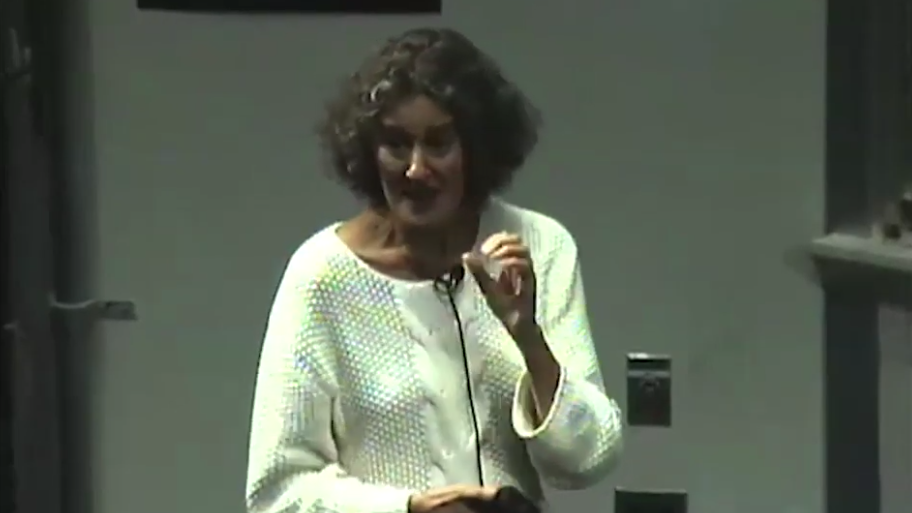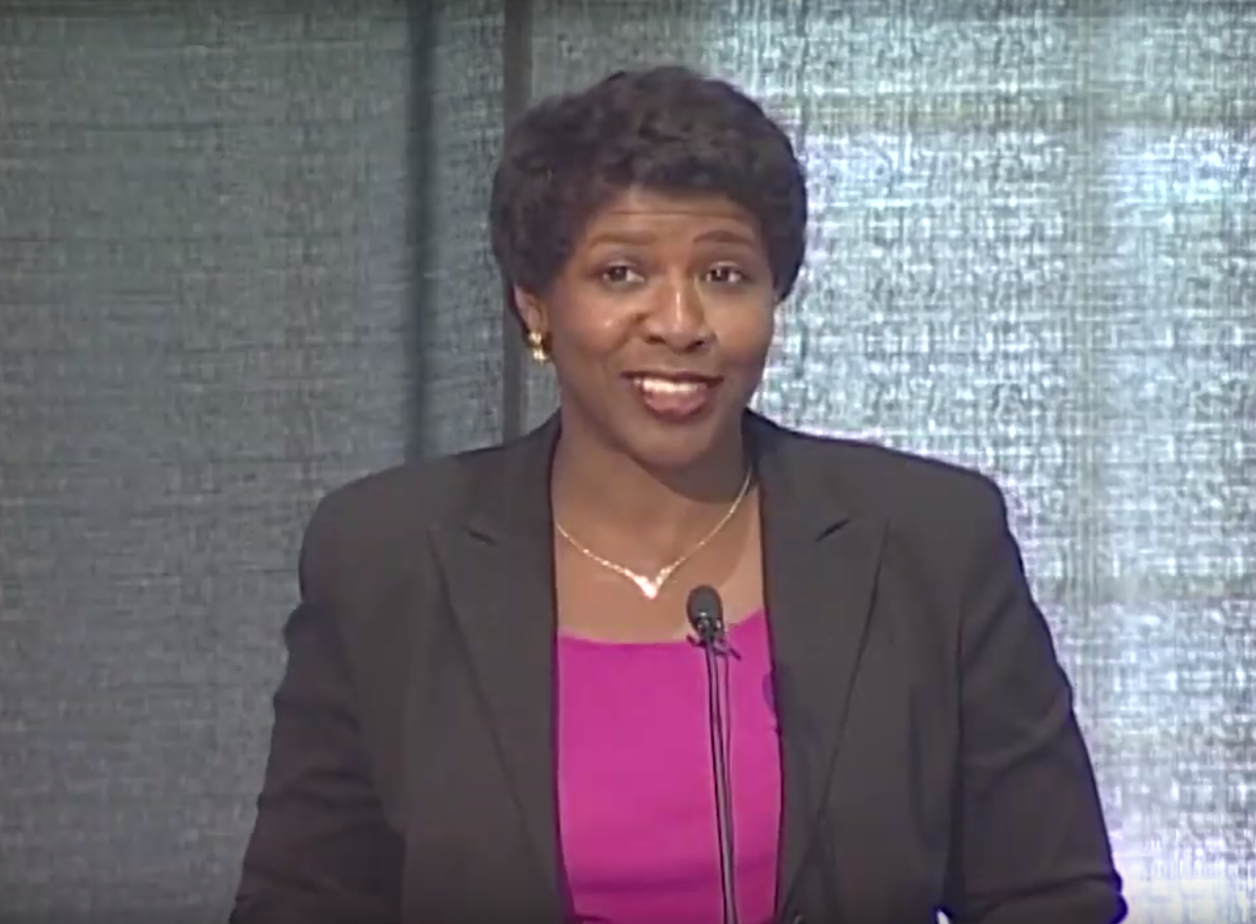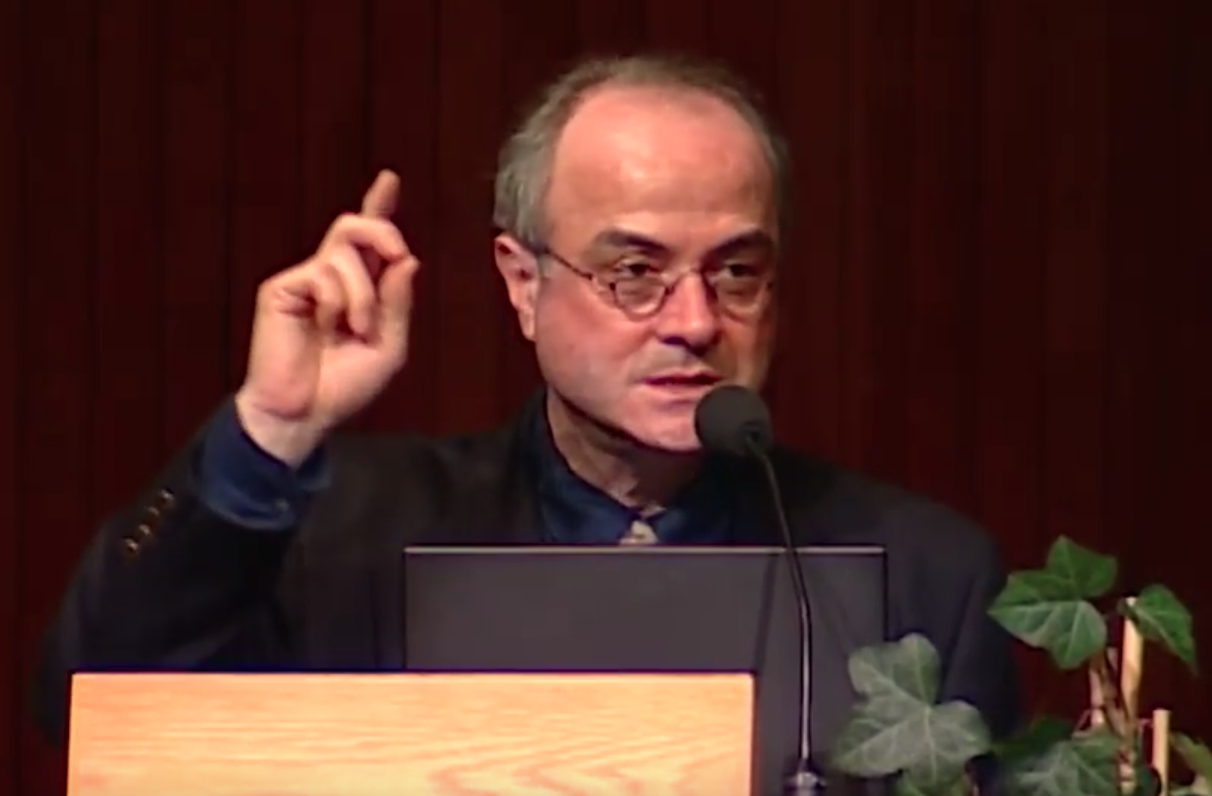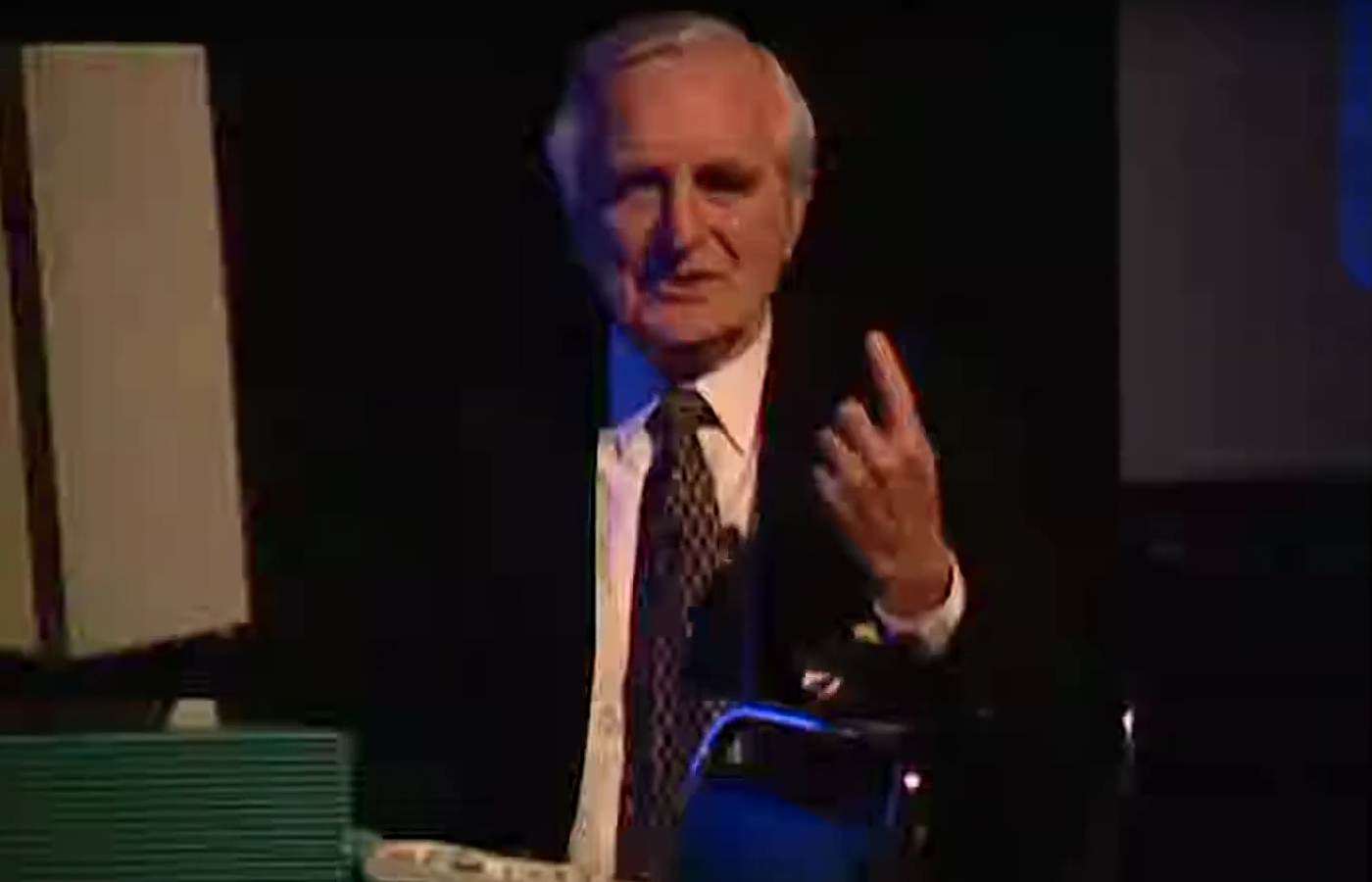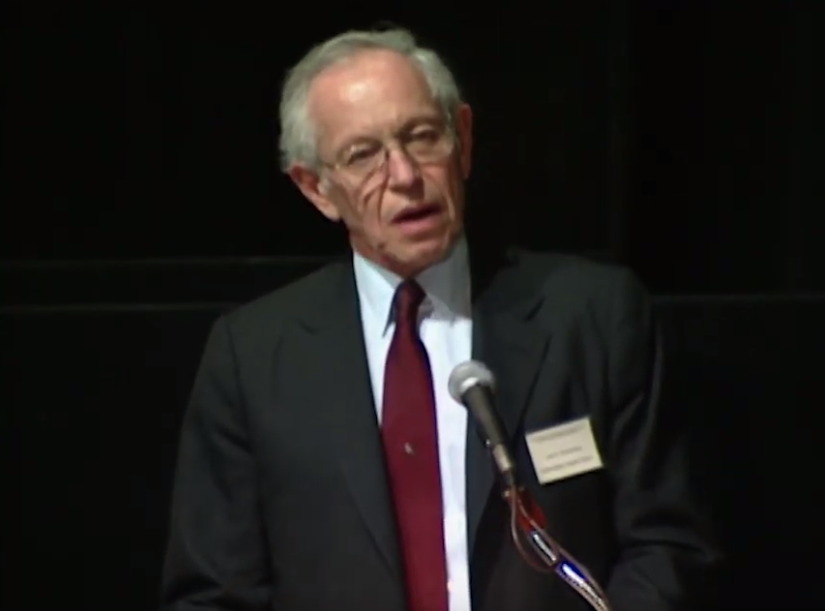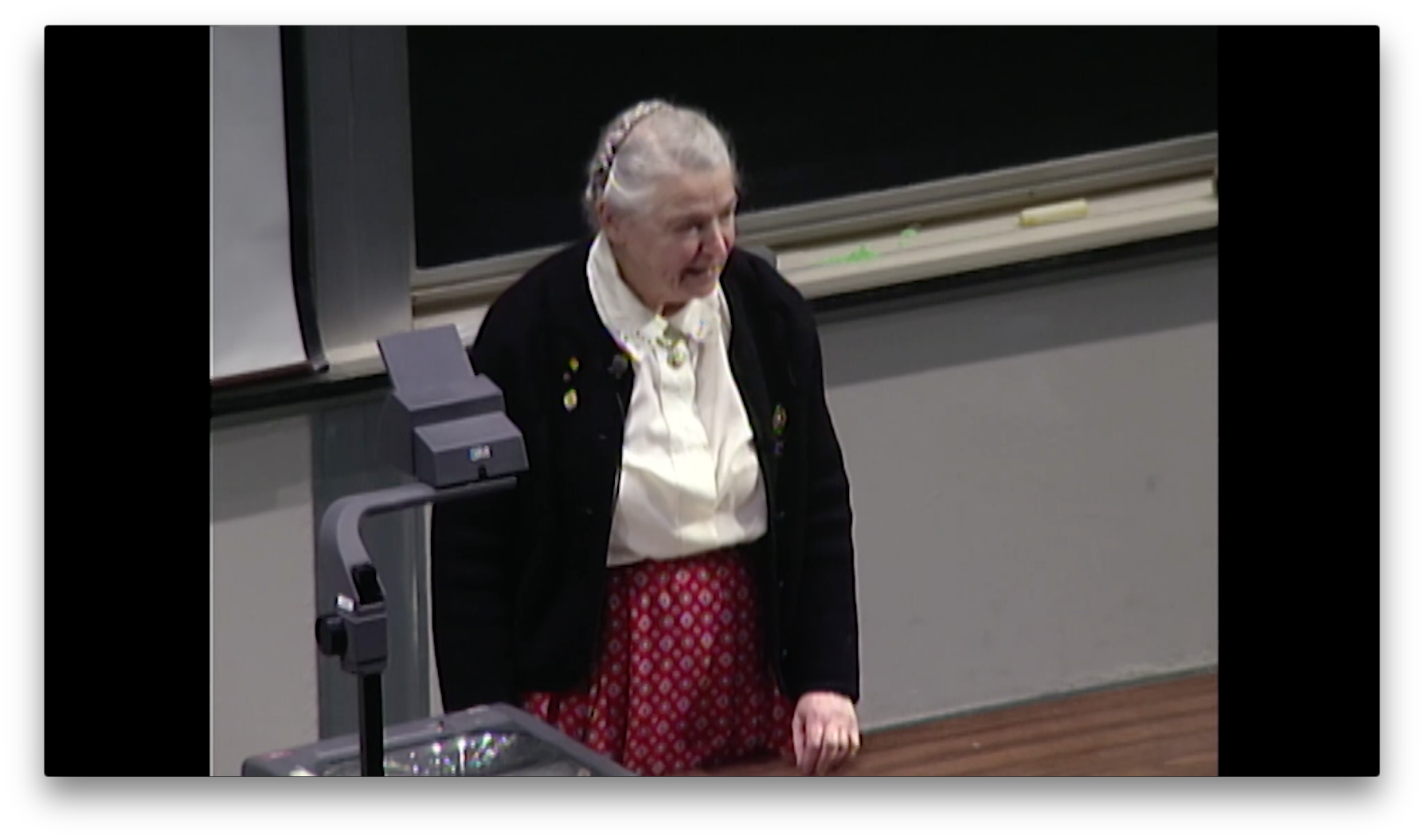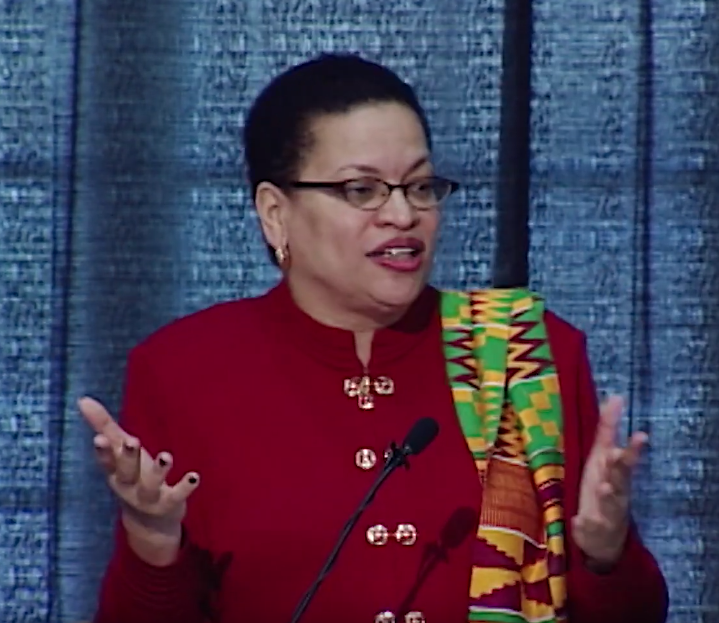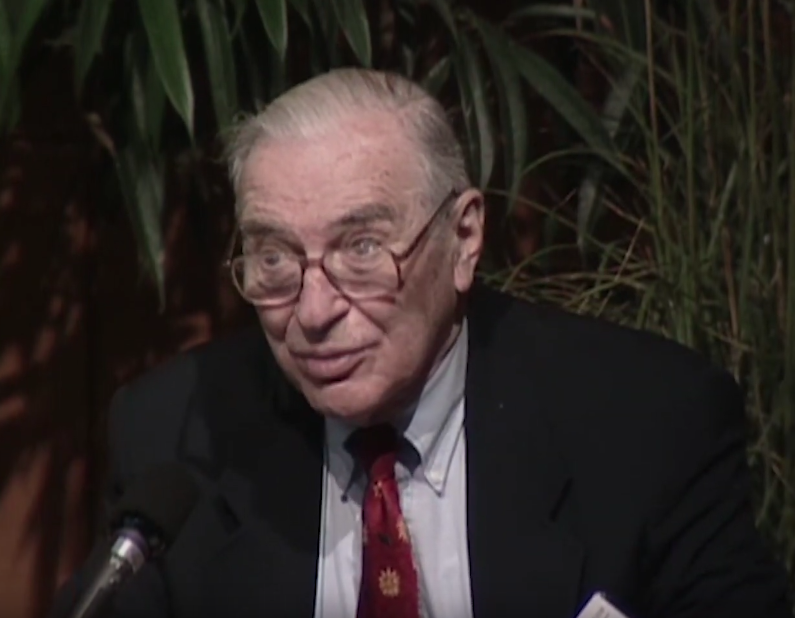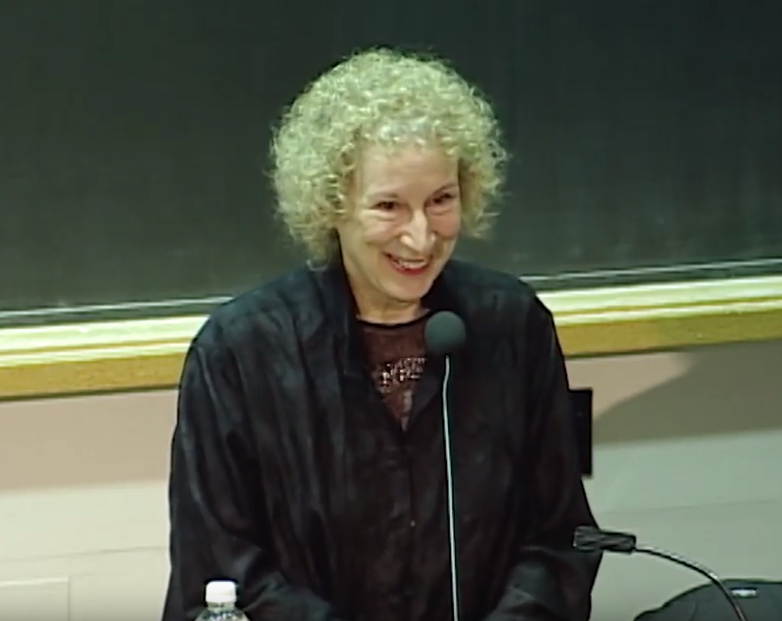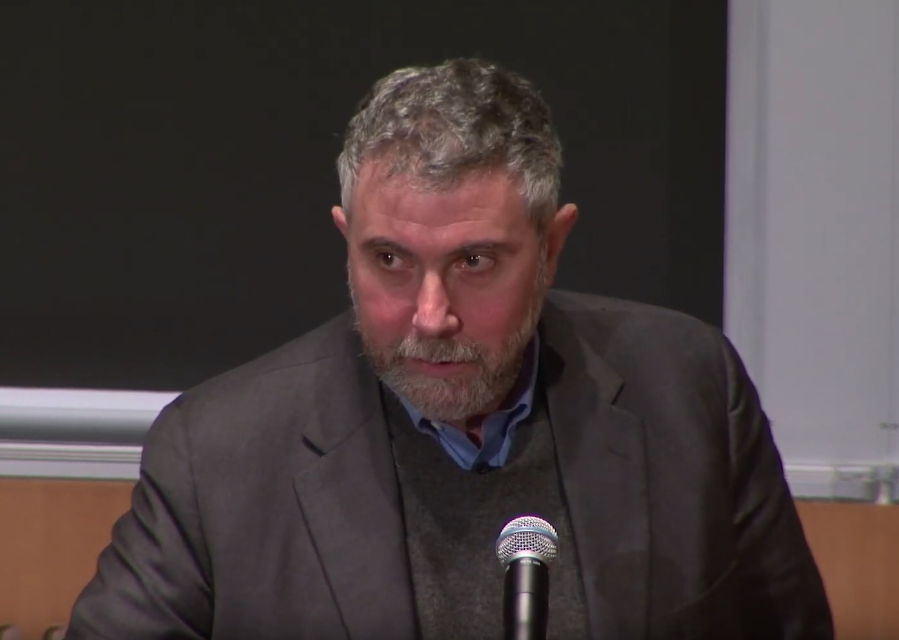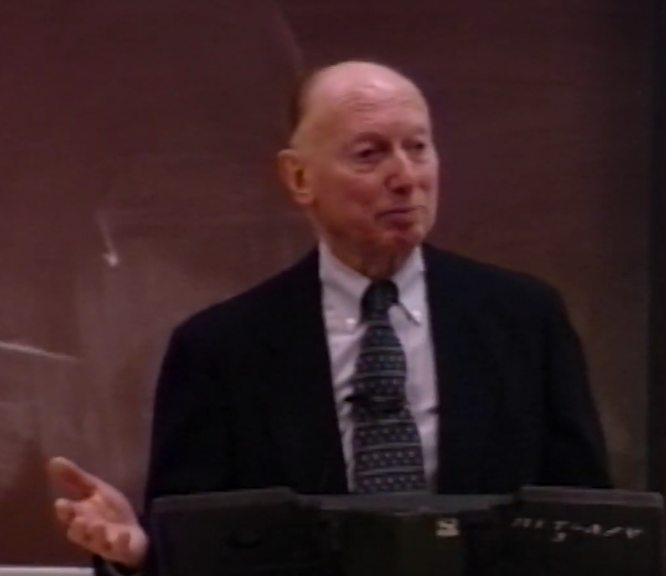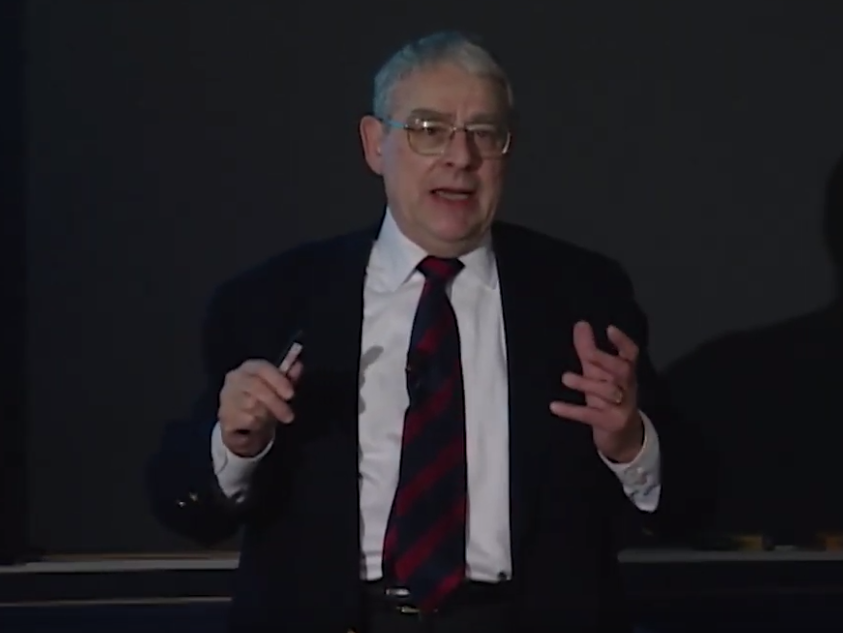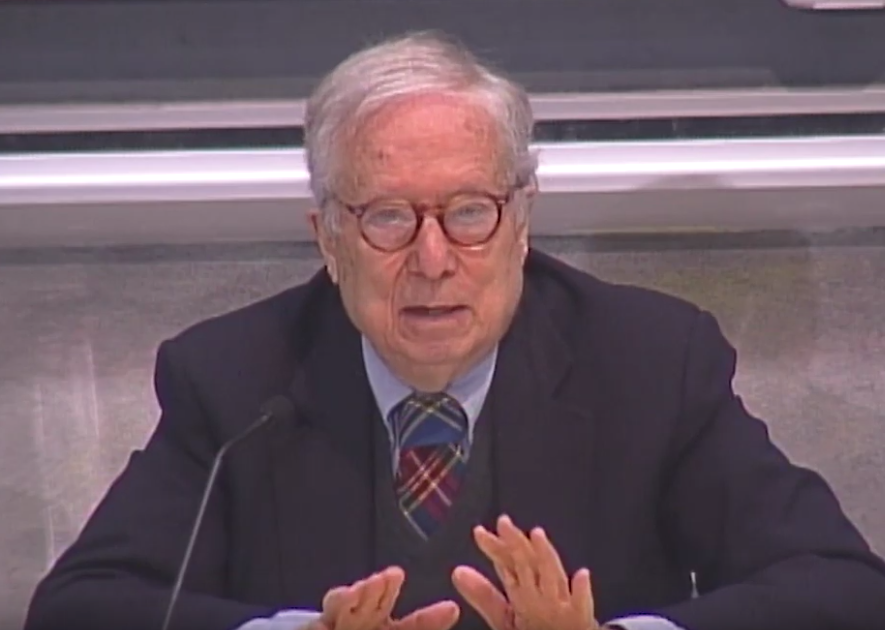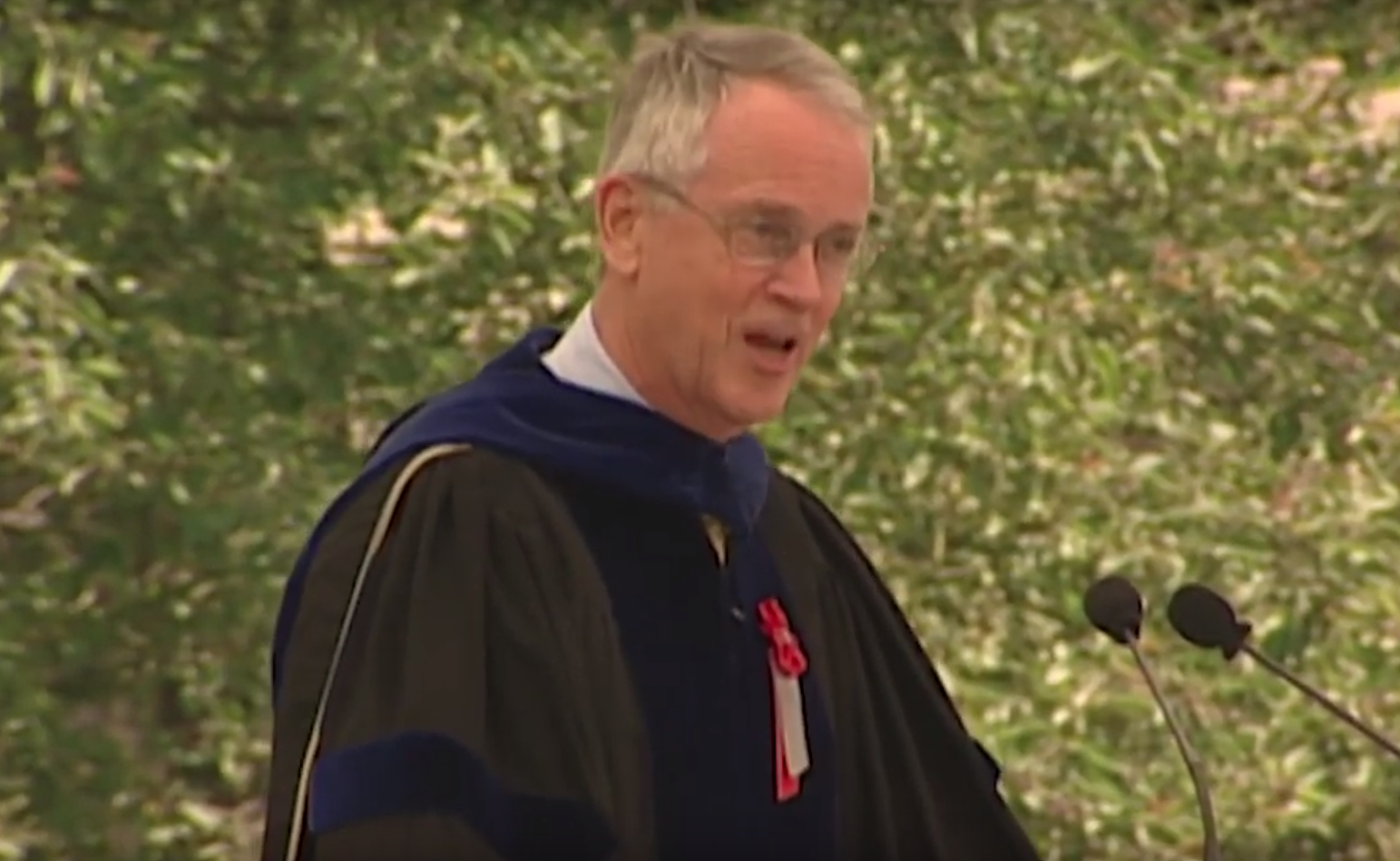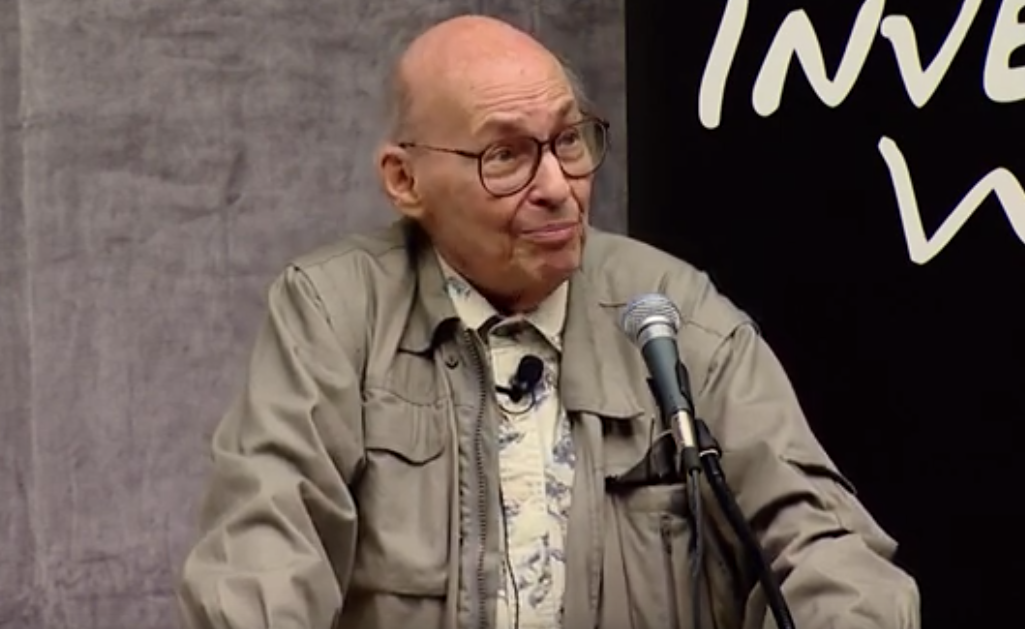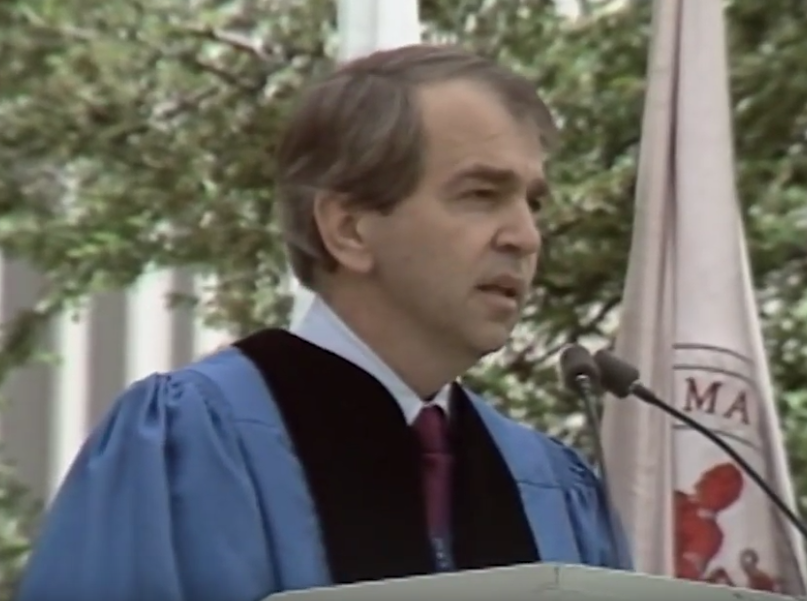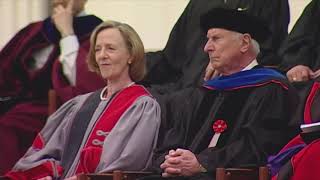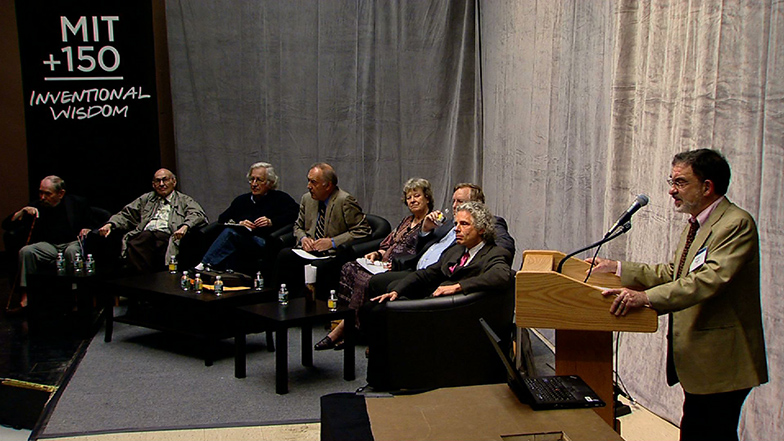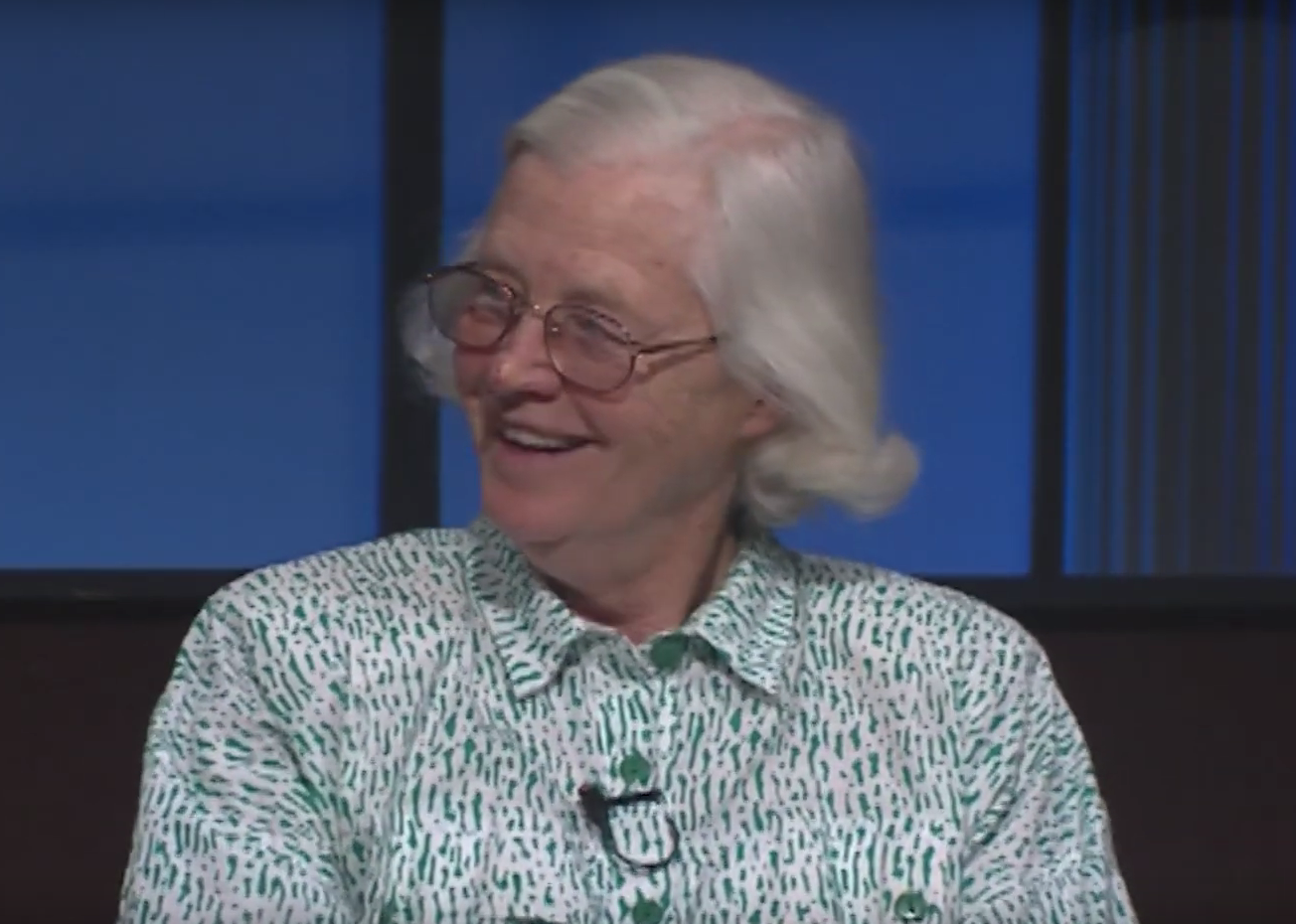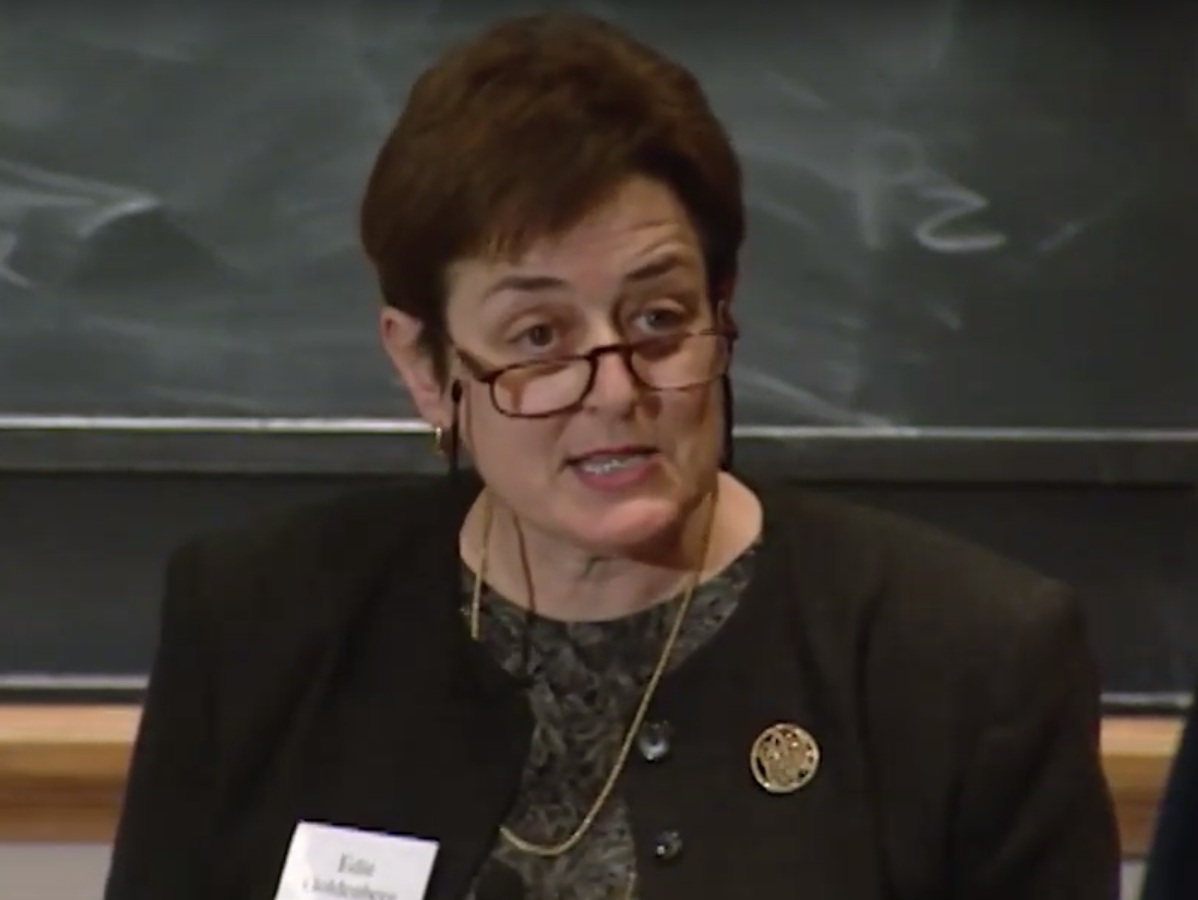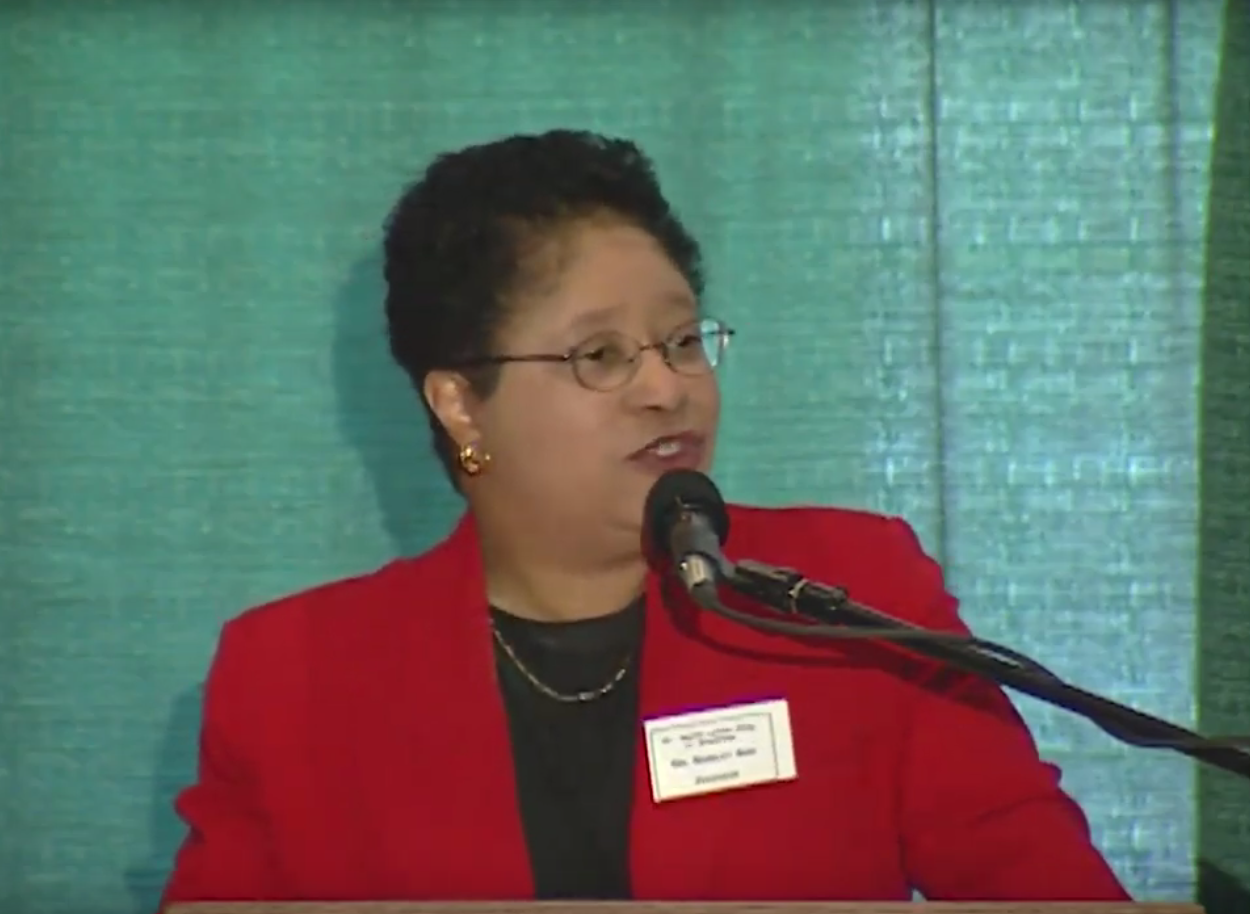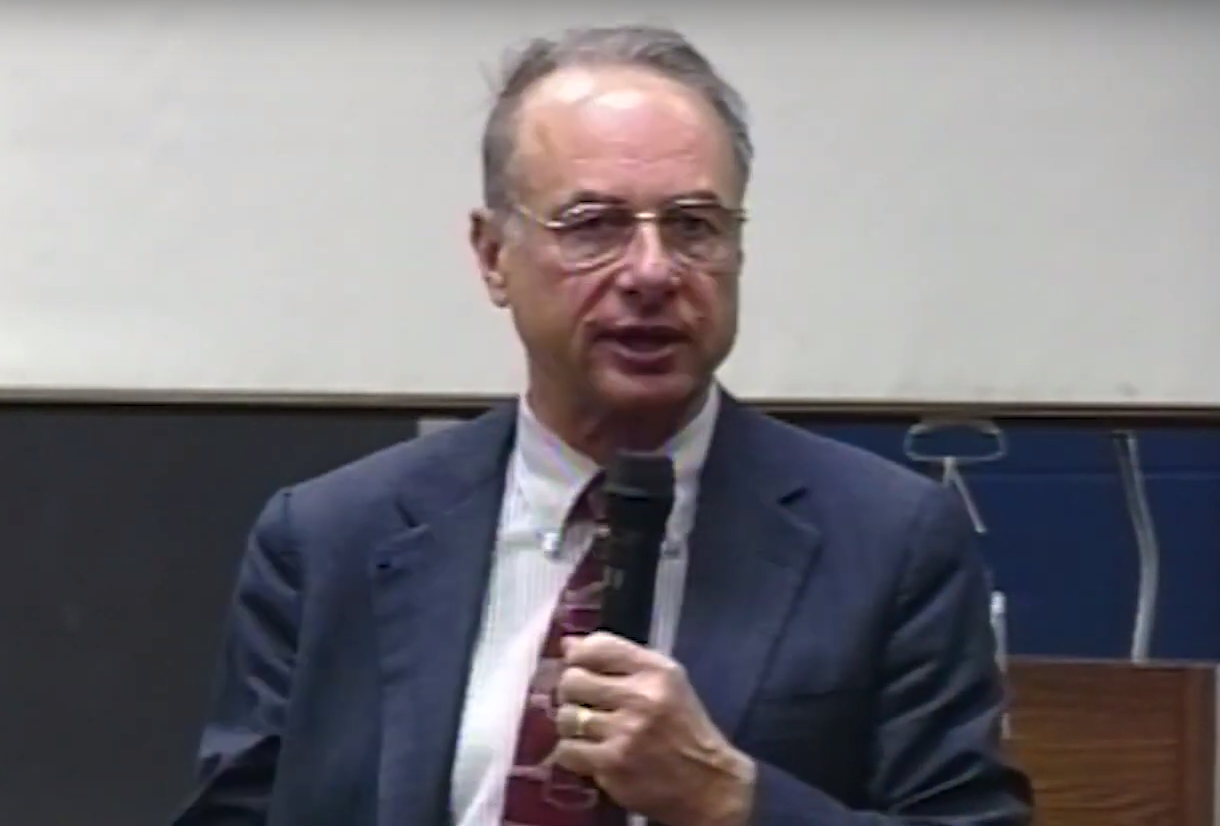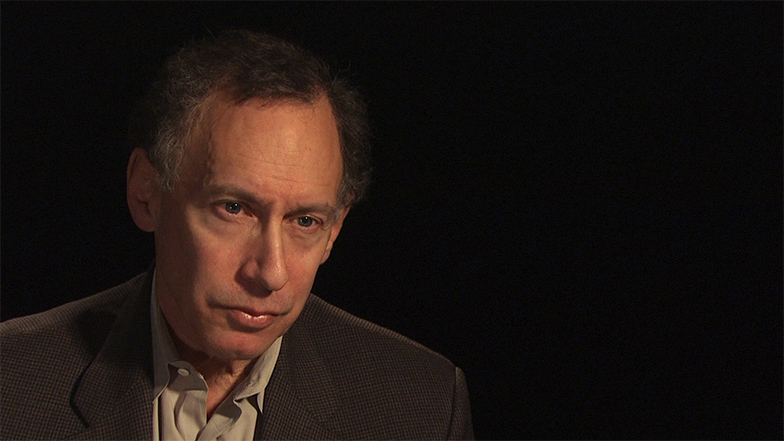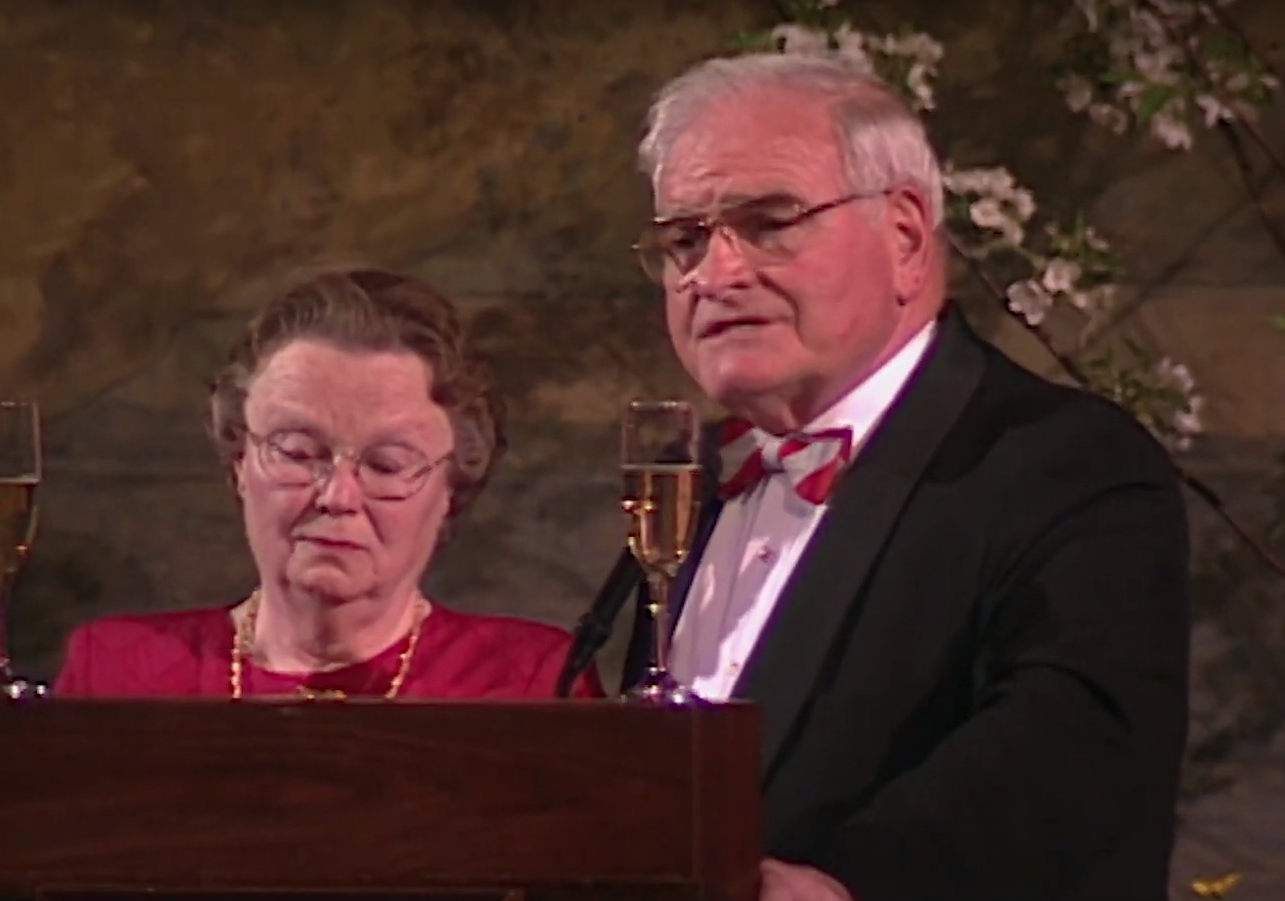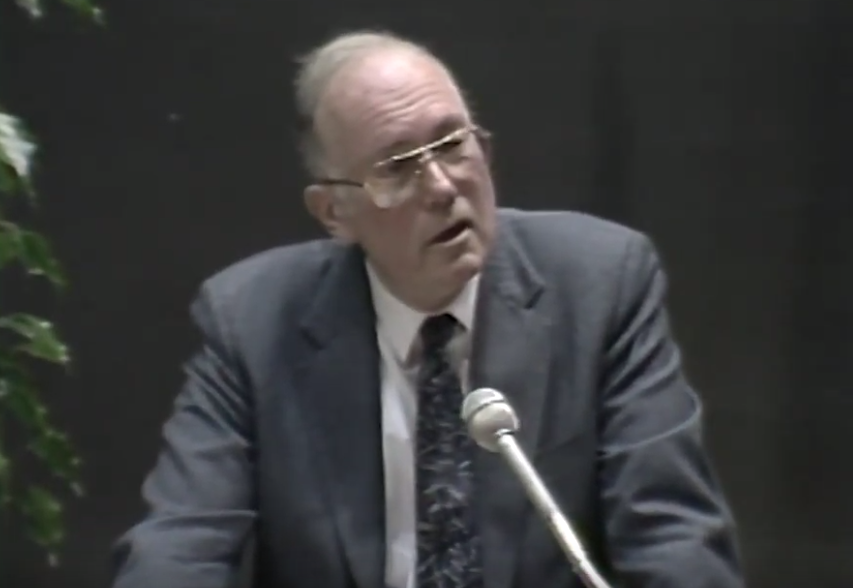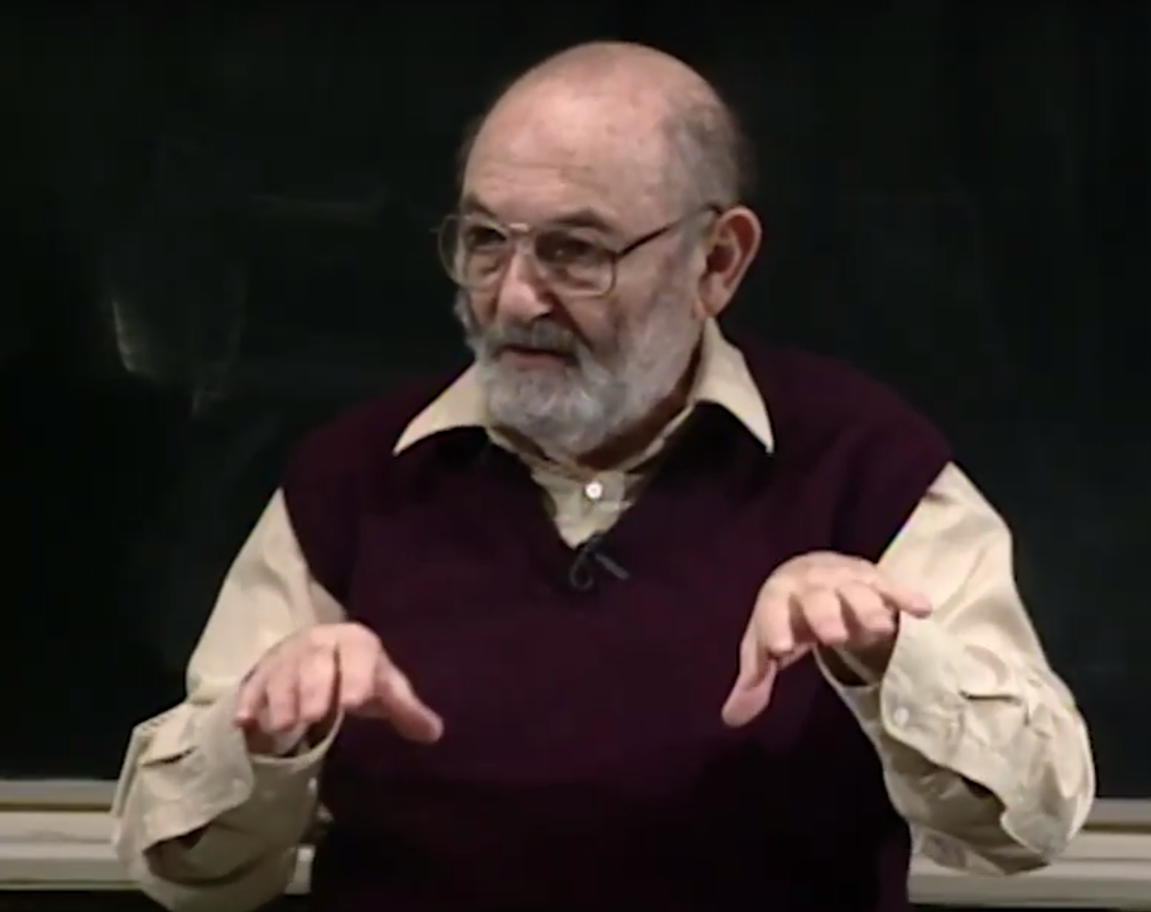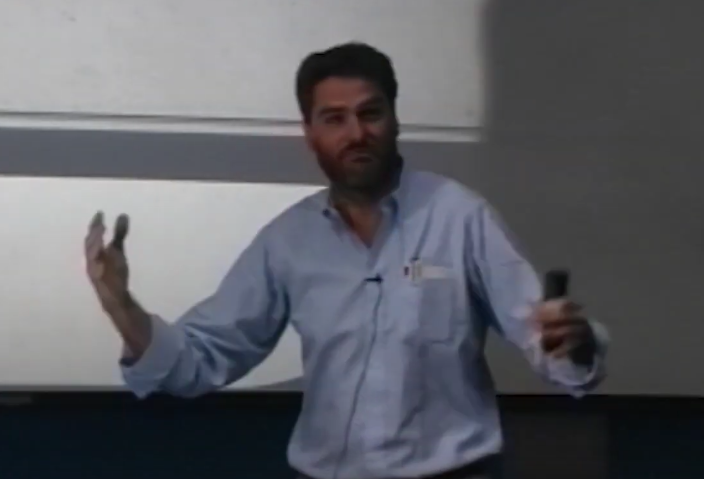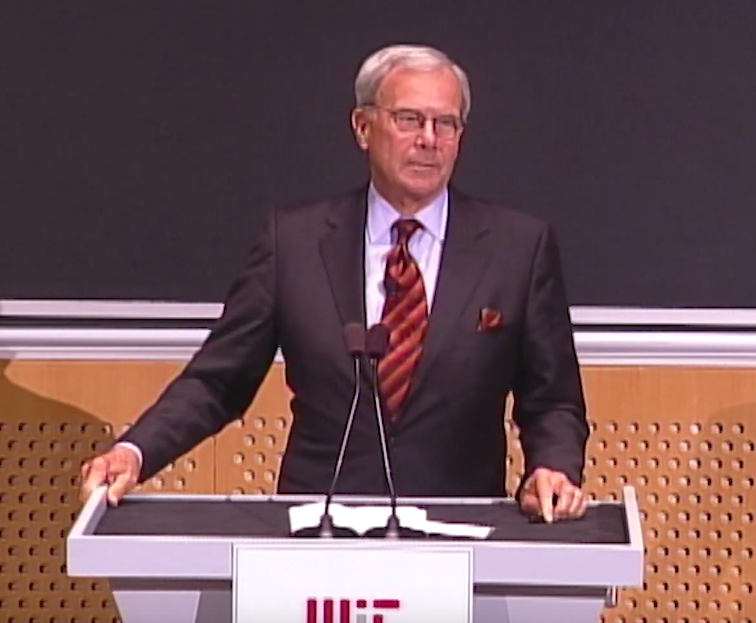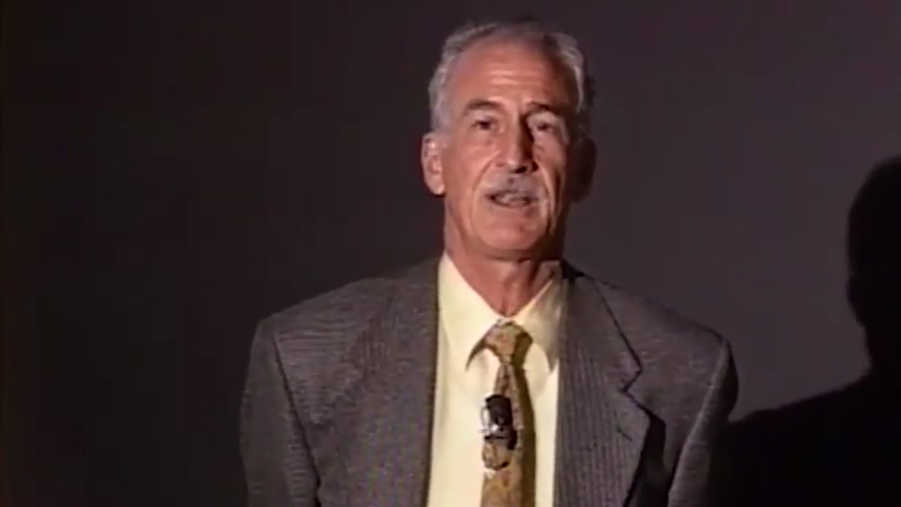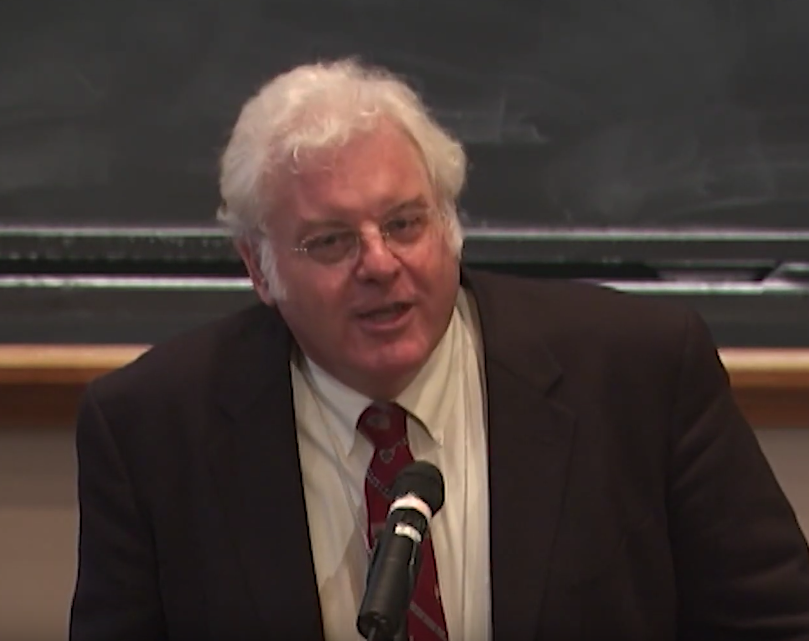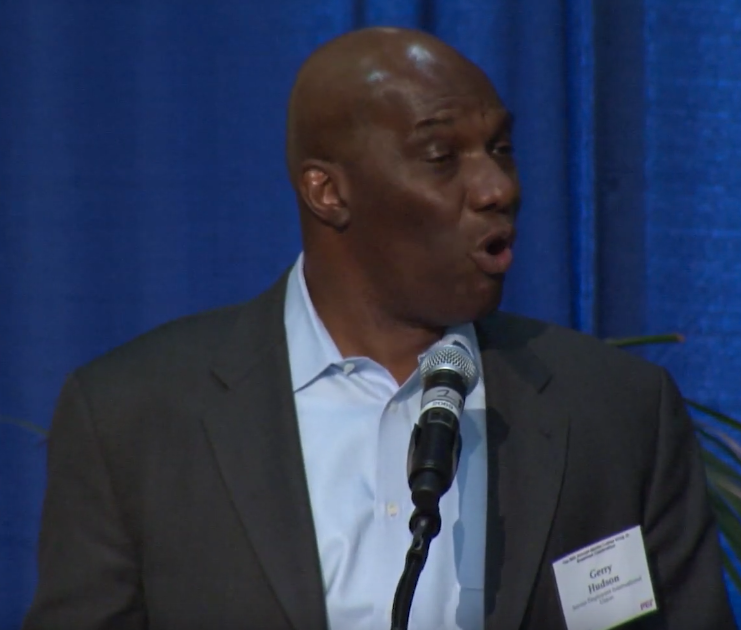White House Office of Science & Technology Policy, 25th Anniversary Symposium (pt.3) MIT
[MUSIC PLAYING]
MORGAN: Well, two of our speakers this afternoon have obligations elsewhere and need to get out of here on time. This has been just a fascinating morning of history taught by those who actually lived it.
We're going to move on now to talk about a set of issues related to the present and the future. But before we do, since many of you didn't live this history, I thought I should yield to the professor in me and offer a very short list of suggested readings, since this is a topic on which there has been, in fact, a great deal of academic endeavor.
We heard already this morning about several books that Bill Golden has edited, the most recent of which is called Science and Technology Advice: To the President, Congress, and Judiciary. It's a series of essays by more or less everyone who spoke this morning, plus a large number of others.
Another nice discussion of many of the issues we heard about this morning is a book by Greg Herken called Cardinal Choices: Presidential Science Advising From the Atomic Bomb to SDI. And it picks up the theme that was present in many of this morning's discussions about the very large role that defense and Cold War considerations have played through much of the science advice of that period.
Third on my list of four is a book by Bruce Smith, The Advisers: Scientists in the Policy Process, which is broader than just presidential science advising. It also talks about things like Defense Science Board and EPA Science Advisory Board, but has a chapter on White House science advice.
And finally, a lovely new book, which makes a very good companion to Hunter Dupree's classic that took science technology policy up to about the time of the Second World War is a book by David Hart, Forged Consensus: Science, Technology, and Economic Policy in the United States, 1921 to 1953.
Now it's also a great pleasure-- some of you have figured out what's going on here. Morgan is stalling a few minutes to get more audience into the room for our speakers. But it's also a great pleasure to be here at MIT, at this function convened by the Technology Policy Program, the first of what I believe is planned to be a series of functions of this sort in the years to come.
Technology Policy Program here has become part now of a larger organizational group, this Engineering Systems Division, which incorporates a number of policy and also management-related activities under one cross-cutting umbrella that cuts across several departments of the engineering college. And those of us who have worked in this area for a long time and observe activities at MIT are really rooting for this to be a big success, because to the extent things succeed at MIT, they will succeed in many other places.
TPP was built through 24 years of enormous effort and dedication by Richard de Neufville and a number of colleagues. And it's now, as you heard this morning, in the very capable hands of Dan Hastings.
This morning, Chuck Vest described TPP as, quote, "The largest program of its kind." It is the largest master's program in this field, though as a guest here, I guess I have to be well-behaved. I can't resist noting that the Department of Engineering and Public Policy at Carnegie Mellon has the largest undergraduate program, the largest doctoral program, and the largest interdisciplinary tenured faculty in this area.
[LAUGHTER]
All right. Well, I've stalled long enough. We've got about half the audience back, so let me do three quick introductions. This session is called Cross-Cutting Issues, and the first speaker is Rita Colwell. She's going to talk to the topic the human capital crisis in science and engineering.
Dr. Colwell obtained a multidisciplinary education in bacteriology, genetics, and oceanography. Now she's had a very distinguished academic career at Georgetown University and at the University of Maryland. She's a member of the National Academy, and has held many important positions and served in many advisory capacities, including service as a member of the National Science Board, President of the AAAS, and a number of others. She currently directs the National Science Foundation.
The second speaker this afternoon will be William Wulf, and his topic is New Engineering Ethics: Great Achievements and Grand Challenges. Dr. Wulf's formal education was in engineering physics, electrical engineering, and computer science. His distinguished career has included a tour on the faculty at Carnegie Mellon University, time spent as CEO of Tartan Laboratories, and time on the faculty of the University of Virginia from which he's currently on leave, serving as President of the National Academy of Engineering.
And the third talk this afternoon in this session is by Dan Hastings, who's going to talk about technology and policy education needs. Chuck Vest has already given you a rather full introduction for Professor Hastings, who holds a PhD in aeronautics and astronautics. And after a distinguished tour as Chief Scientist of the Air Force, has recently returned, as I said, to a faculty position at MIT that involves appointments both in aero astro and as head of the Technology Policy Program in the newly created Engineering Systems Division.
[APPLAUSE]
COLWELL: Good afternoon. It's a genuine honor to join all of you today. And my thanks go to Chuck Vest and Daniel Hastings for inviting me and to MIT for hosting all of us.
Before I start my talk, I'd like to point out, just hot off the press, is the NSF strategy in brief. If any of you are interested, I've left a few copies on the table. It simply describes how NSF operates, our strategic goals, and our core strategies.
Well, there's no question that OSTP has been vital to our nation's scientific and technological advancement. Just as was mentioned this morning, just as Merlin used his great visionary powers to counsel King Arthur on the affairs of Camelot, each science advisor has done a magical job advising our presidents on science and technology policy. And the variations of the theme have been fascinating to listen to.
The OSTP directors have brought a very rich and diverse set of perspectives to the position, ultimately steering our nation in a direction that's enhanced the growth and development of our society, our economy, and most of all, humanity.
It's fitting that we address the topic of the human capital crisis in science and engineering. Attracting women and minorities into these fields has been a concern of mine for some time, and so I've titled my remarks Confronting the Human Capital Crisis: Tapping the Talent.
I will talk about the future of the science, engineering, and technology workforce, though I do think that the charts we saw this morning comparing electrical engineering and parks and recreation and related subjects was pretty dramatic, if not devastating.
Then I'd like to talk a little bit about what NSF is doing through its efforts of recruiting women and minorities in its K-12 programs to develop the workforce. And this is an issue that is critical to all of us. It's been a theme running through many of the talks this morning.
At NSF, it's the very core of our vision and our mission. The National Science Foundation is as much about preparing a world class workforce as it is about discovery. Although we continually break new ground through the research and the education we support, we need people to turn that new knowledge into innovation.
Now, worrisome signals about the science, engineering, and technology workforce are much too familiar. We've heard of the shortages of skilled workers that have plagued the IT, the information technology sector, and the numbers of computer scientists coming out, 800 or so. That's appalling.
Well, here are some other data. While degrees in engineering, physical sciences, and math and computer sciences are either static or declining, as we have seen, other nations are boosting degrees in all these fields.
Carrying a little bit further from the data that was provided in the charts, let me put it another way. A 24-year-old in Japan, for example, is three times more likely to hold a bachelor's degree in engineering than a 24-year-old in the United States.
And the recent studies report that graduate enrollments in science and engineering have increased in the US for the first time in a decade. Unfortunately, that's the good news. The bad news is the growth is almost entirely the result of an increase in the number of foreign students.
Graduate enrollment in these fields among US students has continued to decline. From 1986 to 1997, bachelor's degrees in mathematics declined by approximately 30%, from 16,000 or so to about 12,000 or so. Since 1998, the number of doctoral degrees awarded in science and engineering dropped 5%. There was a slight uptick in 1999, but that was due, as I said earlier, entirely to foreign student enrollment.
Well, the lesson that we should take from these examples is not that we should discourage foreign students. It's about tapping the full range of the nation's native-born science and engineering talent. We're simply not producing enough workers trained in science, math, and engineering to meet the needs of today's technology-based society. And that's where the crisis is.
I quote from a report released in January by the US Commission on National Security for the 21st century. I'm sure that most of you are familiar with it. And it states very bluntly, "The inadequacies of our systems of research and education pose a greater threat to US national security over the next quarter century than any potential conventional war we might imagine." Very strong words. If ever there were any question about the nation's need to develop its science and engineering talent, this should banish all doubts.
Well, what should we be doing about this situation? The title of another recent report suggests an answer. It's Land of Plenty: Diversity as America's Competitive Edge in Science, Engineering, and Technology.
That report, it provides the findings of a congressional commission on the advancement of women and minorities in science, engineering, and technology. We refer to it as the COMSAT report. It was chaired by Representative Morella from Maryland, and it was co-chaired by Representative Eddie Bernice Johnson from Texas.
It issues a very clear call, a warning. We are making some strides toward including everyone in the general workforce, although we do have a distance to go, but there's some progress. Unfortunately, we're not making significant progress in changing the composition of the science and engineering workforce. It still looks mighty exclusive. Well, in the parlance of my children, pale, male, and they would say stale, but I didn't say that.
Although white males make up about 42% of the US workforce, they constitute nearly 70% of the science, engineering, and technology workforce. Women of all races and ethnicities make up only 15% of the S&T, the science, engineering, technology workforce. African Americans and Hispanics of both genders, male and female, account for about 3% each.
The general workforce already reflects much more gender equality and racial and cultural diversity. Projections show that growth in the US labor force through 2008 will come mostly from women and minorities. The growth will come from expanding the pool of science and engineering talent, and we need the talent of every worker in order to compete and prosper.
That expansion must come from the mostly untapped potential of underrepresented minorities and women. And I'd like to say that that, in fact, represents America's competitive edge for the 21st century.
The National Science Foundation is committed to building a science and engineering workforce that's inclusive and draws on all the talent in the nation. And in fact, people don't really view the NSF as a people agency.
We fund 200,000 people every year. 70,000 or 80,000 teachers, 35,000 to 40,000 graduate students, undergraduate students, high school students, faculty, and various programs. That is not even to mention those that are touched by the IMAX films, Public Radio broadcasts, and so forth, which reaches out to about 50 million people.
I'd like to tell you a little bit about some of the things we're doing at NSF to address this issue. I'll begin with recruitment of women and minorities in science and engineering, and then I'll talk about the K-12 education programs.
One of the newest programs at the National Science Foundation-- it went on the web just a month ago-- addresses the very small numbers of women in science and engineering. It's called ADVANCE.
The program intends to catalyze system-wide changes in universities. That is, to induce change in the universities and colleges that will foster a more positive climate for women to pursue academic careers.
And ADVANCE also aims to bring more women into science and engineering. It addresses what we inelegantly refer to as the two-body problem or the trailing spouse, and that is to provide an opportunity for funding for women who are returning to the workforce or who are moving because their husband has taken a position in another institution. It's an opportunity for them to have funding in order to move with the spouse.
And it's also open to men, spouses of women who have received a position in an institution. It allows them, the husband to apply, since he's part of a two-body problem.
The message is that NSF values and rewards the hard work needed to change the conditions for women in science and engineering. And this will give participants an opportunity to make a real difference over the long term.
Now I'd also like to mention the Louis Stokes Alliances for Minority Participation. These alliances target the underrepresentation of minorities in science and engineering. It's about 10 years old. The program links two and four-year educational institutions with business, industry, and government. And there are now about 28 alliances across the United States.
The key features of the success include a summer bridge program to help high school graduates prepare for college, as well as provide them with research experiences and mentoring. A study done by the National Science Board back in 1988 shows that one of the most powerful correlates of success in science and engineering measured by a senior position or success in a prize, a Nobel Prize or last reward or full professorship or whatever is the opportunity to do research in a laboratory with a mentorship being provided.
Now the programs have made a real impact on the number of degrees awarded to minorities in the alliance institutions. In 1990, before the program began, degrees in the first group of institutions, the two-year institutions, totaled under 4,000.
By the year 2000, this had increased to more than 7,000. For all of the alliance institutions, the total by the year 2000, last year, was over 21,000 degrees, a number that continues to grow. And I would say that's success by any measure.
I should also underscore that NSF's largest investment in women and minority scientists and engineers is through our ongoing research and education efforts. NSF support for women researchers, for example, has tripled over the last decade to about $500 million, about half a billion dollars. We still have a long way to go, I certainly would admit that. But we are reaching out and cashing in on the talents and skills of many more of our citizens.
Now another area where we need to do a better job tapping the nation's talent is with a K-12 science and math education. Here's where attracting more women and minorities to bolster the S&E workforce really begins.
Today, however, far too many girls, women, minorities fail even to cross the threshold into science and engineering. We know that there are lots of obstacles and stereotyped cultural conditioning that begins to appear very early in life. And we refer to the grades between four and eight as the valley of death. And interestingly, not only for girls, but also for boys, where the interest that's so keen in the first few grades in science, engineering, discovery wanes and is socially sort of dissuasive.
Now I've often told the story of how when I was in high school, girls were simply not allowed to take physics. Yes, that's true. More to the point, my high school chemistry teacher told me I'd never make it in chemistry. Girls couldn't do chemistry. Later on in life as an undergraduate student-- and I won't say where-- applying for a graduate fellowship, my department chair said that he didn't waste fellowships on women.
Well, today, no one would ever say outright they would not waste a fellowship on a woman. Yet when we consider how to attract women and minorities to science and technology, we really have to begin by re-examining our assumptions about education across the board, from kindergarten to lifelong learning.
And this is an absolute imperative for today's children if they're going to participate successfully in the workforce of tomorrow. And yet, too many of them leave science and technology and just abandon it before they leave high school. This is all part of a much larger challenge.
Most of us are familiar with the results of the Third International Mathematics and Science Study, better known as TIMSS. It's become almost a mantra, unfortunately. The study compared the average performance of US students to students in other countries. Although US fourth graders performed above average in the study, performance declined by eighth grade. And by the 12th grade, US students were right at the bottom.
The most recent TIMSS study, repeated only for the eighth graders, was released just a month ago in Washington. We had a press conference. It gives us some reason to be hopeful, but it still shows a long way to go, because some of the individual school districts made it to the top of the international rankings. And so that suggests that, yes, we can raise the performance of US children through improvements in the quality of K-12 education.
Now we at NSF are really pleased that the president has asked us to lead the math and science partnerships called the No Child Left Behind education initiative. At the center of NSF's FY 2002 budget request is $200 million of a five-year, $1 billion investment. And this will be used to strengthen and reform K-12 science and math education.
NSF will provide funds for the states and the local school districts to join with institutions of higher learning. For example, the local school districts in Boston with MIT. The goal is to help ensure that all K-12 students have the opportunity to perform to high standards in science and math.
And we're asking scientists, mathematicians, engineers at universities and colleges to work with educators in the elementary, middle, and high schools to achieve some very ambitious goals. The partnerships program aims to strengthen math and science standards, to improve curricula in textbooks, and to raise the quality of teacher professional development. Bringing research experiences into the classroom really should help improve student achievement.
But the program doesn't end just there. We hope to eliminate the performance gap between minority and majority students and reach underserved schools and students in creative new ways.
Well, let me point out just one other program that's very important that's been proven very successful, and that's our GK-12 program, graduate student K-12 involvement. The program works with having an individual scientist and an institution or an engineer, a higher education institution partnering with a teacher in the elementary, middle, or high school, and developing a program to enhance science and math education.
Funding goes to graduate students. They receive a stipend of $18,000. And we hope with the new money provided in our budget to raise the stipend to $20,500, though for the graduate students in the audience, we would like to raise it to $25,000.
In any case, this provides an opportunity for the student, who receives the stipend has grant fees and tuition covered, to then spend 20 hours a week with a school teacher in the elementary, middle, or high school, providing the content, the mentorship, and the excitement of the research. And perhaps schoolchildren will learn that engineers do things besides drive trains.
Well, let me stop here. I look forward to a bit of discussion. My simple message is one of always pushing ahead, constant improvement, meeting ever tougher challenges. We've made some tremendous steps forward across our society. In some areas, science and technology has inspired the progress that we have made. In other areas, we've trailed. Now we can change that, and I know that all of us are committed to making a difference. Thank you.
[APPLAUSE]
MORGAN: Do we have a question or two? Yes?
AUDIENCE: I think it's marvelous, the programs you've outlined. And how are we getting [INAUDIBLE]? But the thing that concerns me is-- I looked at all the figures and data. The thing that concerns me is, what about the other end? Is it realistic to think even at the K-12 level that unless people can see a secure future in the sense that if you get a good education and do well that there'll be a good job for you? Is it realistic to think that people will flow into these fields?
For instance, I think we may have a crisis in biological sciences, because we already have an enormous oversupply of people in postdoctoral positions. That may not be oversupplied compared to some measure of demand, but it is compared to jobs. And so is someone looking hard at what we do at the job end?
COLWELL: Well, there's a very serious anomaly. On the one hand, we were increasing H1-B visas to bring in nearly 200,000 people technically trained from other countries. 55,000 from India alone from the Indian Institute of Technology, and other very productive institutions there at a time that now we are seeing a cascade in job opportunities. In other words, we cannot address our needs for science and technology talent by importation. It doesn't work.
What we need to do is reflect on how we are educating. And in fact, to produce students who graduate, who are flexible, and who will be prepared as they must to have seven or eight career changes before retirement. You and I could expect to stay in one job or one kind of-- for example, I'm a microbiologist, and I'm still doing microbiology. That isn't going to happen for those who graduate this spring.
And so we need to not only focus on how we're teaching our students, but also on what we're teaching them, and then for the expectations that we are providing them. We do have a tremendous need for mathematicians across all of society. I don't think we will have a glut even if we are successful in the push that we're making to put more money into mathematics. I could go on and on for an hour about that. I won't.
MORGAN: Yeah [INAUDIBLE] question. Unfortunately, we have a hard 3 o'clock deadline for [INAUDIBLE]. So I'm going to stop now, and perhaps there'll be an opportunity for another few questions a little later in the program. The program will run full time. Thank you very much, Rita.
[APPLAUSE]
WULF: Sorry. Thanks, Granger. I want to add my thanks to Chuck and Dan for hosting this anniversary celebration symposium. I think this is really nifty. And to get sorted many of the former science advisors here at the same time is really pretty special.
When Dan asked me to speak today, he asked me to in essence repeat the talk that I gave at the annual meeting of the National Academy of Engineering last fall. And so in some sense, this is going to be an abbreviated version of that.
The full talk tried to first talk about the kinds of contributions that engineering has made to our quality of life, and the second half was to look forward and ask, what are the challenges facing engineering for the 21st century? I'm going to lop off the first self-congratulatory part of the talk altogether, and I'm going to focus in on just one challenge for the 21st century, a challenge that I think may be the greatest one that we have to face. And it is, in fact, engineering ethics.
Now what Dan didn't tell me was that I was going to be talking right after Harold Shapiro talked about ethics. He was vaguely apologetic about not being a scientist. I'll be vaguely apologetic about not being an ethicist as well.
I want to start out by making it clear that I believe that engineers and engineering by and large are very ethical. There are courses in engineering ethics at many universities. There's a stack about two, two and a half feet high of books that have been written just in the last five years on the question of engineering ethics.
ABET 2000, the criteria by which engineering schools are accredited, require an exposure to ethics, at least in the context of a capstone project. And every single engineering society has a professional code of ethics.
The one that most of them are modeled on is from the National Society of Professional Engineers, and it starts out saying that engineers will hold paramount the health and safety of the public. And then goes on in great detail, some 170 or so separate points of specific responsibilities that engineers have to their customers, to the public, and so on.
So with all of that in place, why did I try and tell the academy that I thought one of the greatest challenges for the 21st century was engineering ethics? It's because I think the practice of engineering is changing, and changing in a way that raises new kinds of ethical issues, ones that engineers at least haven't had to face before.
The existing codes of the vast majority of the books, the context in which the ABET requirement is written all deal with what is known as micro ethics. And I don't mean micro to mean small or unimportant, but rather, ethics that have to do with the behavior of an individual as opposed to macro ethics, which deal with the behavior of the profession as a whole.
Perhaps illustrating the point with another field will help. In medicine, the ethical codes that a doctor subscribes to for his or her individual behavior bear an amazing resemblance to the engineering ethical codes. The behavior of the individual is specified in very similar ways.
But medicine has had to deal with some of these macro ethical problems, which engineering has not. The most easily accessible example is allocation. If there are less organs to transplant than there are patients who need them, how do we decide which patient gets them? That's not a decision for the individual doctor.
Similarly, if there's less medicine than the number of people ill, or if there's simply less time for the physician to allocate to all of the people who are ill, how do you do triage? How do you decide who gets the attention and who does not? Again, those are macro ethical questions, because they're questions that either the profession has to decide upon, or perhaps better, society informed by the profession needs to decide.
Well, I said the practice of engineering is changing in ways that raise these macro ethical problems. I'm going to focus on just one such change, again, in the interest of time, and that's the issue of complexity. Particularly, complexity arising from information technology, from biotechnology, and perhaps in the near future from nanotechnology.
Simple fact is it is possible today to build systems for which it is impossible to predict all of their behaviors a priori. It's not just hard. It's not just if you thought about it more, you could do it. It is literally impossible.
Perhaps the best way I can illustrate that is from my own field in computing. We've got some physicists in the audience, and so maybe somebody can give me the exact number, but I believe that there are kind of order of 10 to the 100th elementary particles in the universe. I'm looking at Allan Bromley to tell me whether that's right. Okay, he's saying it is. It's 10 raised to one followed by a couple of digits. Maybe it's 120.
I want you to compare that to the number of states in my laptop. By state, I simply mean the number of patterns of ones and zeros in my laptop. That number is 10 raised to 10 to the 20th power. So whereas the number of atoms in the universe is 10 to the one followed by two zeros, the number of states in my laptop is 10 raised to one followed by 20 zeros.
If every atom in the universe were a computer and every one of them could do 10 to the 100th operations per second, there isn't enough time since the big bang to examine all of the states in my laptop. Okay? That's the sense in which I mean we can build systems that are so complicated that it is impossible to predict their behavior. It's not that there isn't an algorithm, which given enough time could determine all of the outcomes, all of the behaviors. It's that there isn't enough time.
A very concrete example of this was a report issued by the Naval Research Laboratory. One of my areas of research has been computer security over the years. And there was an NRL report about 1993, if I remember correctly, that looked at the reasons for about 50 security failures, lapses in security that happened.
Because the way these 50 examples were selected-- the numbers I'm about to give are not necessarily representative of anything. But of those 50 examples, 22 were errors in the specifications, errors in the sense that a property which was thought to be essential for the correct behavior of the system, it in fact turned out to be the vehicle by which somebody could crack the system.
In every case, it was because the particular way that the cracking was done was not anticipated for exactly the reasons I'm describing. The system's too complicated. It's impossible to predict its behavior.
So the question then is, how does one behave ethically in such cases? What does it mean to ethically engineer when you know that the system that you build will have behaviors that you did not predict, some of which might be negative, some of which might be absolutely disastrous?
And in fact, we have to begin to rethink the process by which we engineer. I mean, the kind of standard process you're taught in engineering school is that somebody gives you a specification for a problem, for a solution to a problem. You go find a design that affects that solution. You build it. You test it. Go home.
Well, I'm sorry. The error's going to be back in the specification, or the problem's going to be back in the specification. So how do we modify the process by which we behave?
I think there's no better example right at the moment than people are talking about remediation of the Everglades. We're about to do some multi-billion dollar re-engineering of the Everglades. Let me tell you, that's one of these complicated systems for which we will not be able to predict the consequences of what we do.
And yet, doing nothing is not an acceptable solution either. Doing nothing is also a conscious decision, and it will have consequences. So how do we ethically engineer in such a circumstance?
I've got another example, but we're going to run out of time, and so let me defer that to any questions, or defer that to questions at the end. I wish Harold were still here. It might get into a more interesting conversation. Thank you.
[APPLAUSE]
MORGAN: Well, I will make the first question to Bill, and then Bill, if time runs out and the two have to run for a cab, I will alternate. So a question. Yeah?
AUDIENCE: Well, although we can't-- although we can't know the-- although we can't know the states of a particular future, we can-- and Dr. Morgan has just written about [INAUDIBLE] in some way that we have some idea about-- like say in the case of the Everglades, we have some idea what will happen over a small period of time. Of course, we don't have large periods of time. And how would you think about that?
WULF: Yeah, I'd like to have some conversations with people who are more expert than I, but a plausible suggestion is that instead of design-- sorry-- specify, design, build, test, you say, well, let's specify a little and design a little and build a little and test a little, and then go back and ask what's happened. But that's a much more organic interaction with whatever it is that you're producing than engineers are accustomed to.
MORGAN: Yes?
AUDIENCE: On the question of large numbers and the impossibility of specification, isn't it a question partly of how and what you specify? Ordinary statistical mechanics is a way of dealing with very, very large numbers. Maybe only 10 to the 30th rather than 10 to the 100th.
But most of the states become outliers on a distribution for which certain macroscopic variables can be defined fine. [INAUDIBLE] in most of the situations one encounters take care of. I mean, can one deal similarly statistically with these large numbers?
WULF: Let's see. In the case of continuous systems, maybe. The trouble with digital systems is that they're not continuous. A one-bit change can lead you to a state which has no relationship to the state you changed from. You don't have continuity. And it's a problem.
MORGAN: [INAUDIBLE] Dr. Colwell. There was one over here that I [INAUDIBLE]. Yes?
AUDIENCE: Rita, we've heard a lot about workforce, and we've talked about micro and macro, and I and everybody applauds what you and others are doing. In a big macro picture sense from a national point of view, if there is a crisis, as your title says, and there is, including the workforce minorities, women, and human beings, what in a big picture sense can we try to do to bring some elevation of political awareness so that there's policy action on this critical, critical issue?
COLWELL: I don't think we've ever had a time more salubrious with respect to the White House actually saying that education is the number one priority for the country. And I think what we need to do is ensure that we take advantage of this wonderful opportunity when there is a focus on K-12 education.
And I think the big problem has been the disconnect-- I call it the scorched earth-- between the elementary, middle, and high school and the higher education. Somehow we have risen above it, which is sort of bizarre. And we need to reconnect, and it is our problem. And I think if we can take advantage of this, this really excellent opportunity and time that we have, we can make a big difference. I really do.
And I really worry about simplistic solutions. They're not simple solutions. One of the things we would like to do-- and I'm going to give you a little commercial here-- is establish centers focused on the science of learning and teaching, and to develop these centers just as we so successfully did for engineering research centers and science and technology centers-- they are a big success-- where we require the industry, the local school system, higher education, the community, and private foundations to be partners and totally responsible.
Provide opportunities regionally for teachers to regain their professionalism, to regain their pride of profession, and then to have a place to go for the best practices, curricula, et cetera. Anyway, I think this could be very effective.
MORGAN: Very good. Here's a mic.
AUDIENCE: Yeah, Rita, I'm sorry. I came in just on the tail end of your talk, but I know what's in it, so it's--
[LAUGHTER]
COLWELL: You've heard it before.
AUDIENCE: I've heard it before. But the question I have for you is this. If you remember back in the mid 1980s, the National Science Board and the National Science Foundation made a big pitch for increased numbers of scientific and technical personnel. If we had followed through with that, we would have not had quite as bad a decline as we've had. I mean, the timing was absolutely correct.
However, the political system beat us to death. And the reason that I know so well is I was on the National Science Board at the time and chair it one time in that period of time, and we literally got slaughtered. That's the only word I can say for it.
And the reason we did was that we had a small recession which lasted for a year or two and a few chemistry PhDs were driving taxicabs. And we just got killed.
Now the problem you have is we are now looking at an economy which is not as robust as it was this time last year, and the issue-- my concern is that we're going to end up with the same kind of response. And if we do, then the next time around-- I mean, it will simply be now twice as bad as it was the time before.
How do we get people to understand that this is not a response to whatever is doing today? And interestingly enough, I have to say this. In the 1985, '86 problem, the universities did not help us.
COLWELL: Well, Mary, there is a difference. Today from that unhappy period of time-- which I remember so well because I too was on the science board with you, as you'll remember.
The difference is that we have had an attitude in the past which served us well, that we would educate the best and the brightest, and they would lead us-- and they did-- into the future as the best in our fields. The difference now is that the technological work skill demands are across the board.
And so in order to be an auto mechanic, you've got to know mathematics. You have to know something about computers. In fact, you have to know about computers, because there are probably 20 or 30 of them under the hood. So I think we have a different kind of challenge than we did at that time.
And also, when you try to predict directions, if you try to predict for kids where they will go, that is a mistake. Again, changing education so that we educate kids who will be lifelong learners, who will be self-educated. And of course, distance education, as MIT is doing so well in making available in its curricula, another way of educating that's very, very important in a new century. So there are differences.
MORGAN: I think we have time for just two more questions. There's one there.
AUDIENCE: There's a great deal of complaining about the lack of people moving into science and technology, but I would suggest there's no real economic evidence that that is a problem. You are not finding the kinds of salaries for engineers that are being paid for MBAs going into consulting companies.
And so when a company president complains to me about the shortage of engineers, and I said, well, would you pay as much as you do for the top MBAs, he said, well, of course we couldn't do that. And there you are.
COLWELL: Well, that's anecdotal, and it's valid. But let me counter with an anecdote as well. A friend of mine who's an African American mathematician, he finished his PhD early last year before the H1-B visas were full, were completely exhausted. They were all taken. And he could not get a job. But as soon as the last of the H1-B visas were gone, then he had several job offers.
So I think there is something very-- there's an important message there that we are not looking to our Native Americans, and we're not providing the job opportunities. And we're using an artificial source for filling the jobs that are very important. And the IT jobs do pay 60% more than the average wage, so they're not exactly crummy jobs, so to speak.
WULF: No, in fact, that's something that ought to be very disturbing to us. A new engineer with a BS degree gets from 50% to 100% more than a person graduating with a BA Degree, on average. And yet, in the face of that, we're still losing market share. We're still getting a smaller and smaller fraction of those people who do enter college, who even have the appropriate math and science prerequisites, opting not to take engineering.
MORGAN: I think that both in the interests of getting two of our panel members out to a waiting cab and giving Dan his whole time, we should stop here. My apologies to the couple of you who still have questions. Thanks again to both Rita and Bill.
[APPLAUSE]
HASTINGS: To finish up this session, which was to look at some of the cross-cutting issues that are affecting the human capital in this country, I want to talk a bit about the need for an integrative technology and policy education. I subtitled this Bridging the Gap.
And the question I want to address today was actually framed by Donald Kennedy, I thought very well, in his insightful book Academic Duty. And in the final chapter he asks the question, can the universities really make a difference with respect to the big problems facing us? And in the actual chapter, the big problems is capitalized, which I can't quite say it that way.
He suggests that the list of challenges facing us ranged from arms proliferation and disarmament to ethical issues in genetic testing and counseling, as we heard today at lunch, to utilization in centers and health care systems. And these issues are indeed intellectually exciting and analytically demanding.
However, the problem is that they do not come in disciplinary packages. And furthermore, he asserts in his book, those who wish to work on them face suspicion in the academy, which he asserts stems partly from the traditional academic reluctance to do, quote, "applied work," and partly from the considerable difficulty of being an interdisciplinary scholar.
And he points out the critiques often heard in these messes that it's so valuable to go to. The critique of those who engage in interdisciplinary work is often their work is watered down or somehow has gone soft. And therefore, it's hard to encourage people, academics to actually think hard about some of these issues. He points out, however, that these issues are indeed real and complex, and they're problems of large scale, and they need the attention of thoughtful intellectuals.
So then the question as he frames in the last chapter of his book is whether the academy can overcome the resistance of departmental structure to re-engineer itself in the face of these challenges. And in this talk, what I want to argue that part of the answer to this big question lies in educating leaders flowing out of a new vision of engineering, which to some extent you heard from Bill Wulf and his emphasis on engineering ethics. This new vision of engineering is going to operate at the interface of technology and policy.
Now in terms of building that argument, I first want to argue that we live in a world of two cultures, and I think we've heard quite a bit about that already today. And secondly, in a world of accelerating technological change with profound social consequences. And President Shapiro made a very good case for some of the consequences in terms of the stories that guide us in our lives here.
And thirdly, I'm going to argue that the paradigm for engineering is changing. And from this new paradigm can emerge the kind of leaders that can transform the academy, if we allow it to actually happen.
The first thing to consider, of course, is here in the first part of the 21st century of modern day America, we see a staggering technological change and innovation. So the reality is even though as Representative Porter pointed out, many in the Congress may not entirely appreciate the worlds of science and technology. Our lives have been fundamentally transformed by science and technology.
It's hard for those people who are much older-- and you talk to people much older, you compare people [INAUDIBLE] today, it's hard to understand the dimension of the changes. So I even talk to my own sons who live in a world where there's always been CDs and VCRs and transatlantic phone calls, and they just don't think of anything else. That level of communication has just changed their lives in ways that they don't even completely appreciate.
Now an awful lot of that, of course, has flowed from the success of what's occurred in the academy. A lot of the inventions and discoveries-- not all of them-- have flowed from the academy. And in that sense, a disciplinary formulation has proven to be, you've got to say on the basis of the evidence, remarkably successful.
However, we still live in a world of two cultures. Many people, as Representative Porter suggested, who end up in leadership come up through a liberal arts education. The liberal arts education very correctly emphasizes the human condition, but gives relatively little shrift to the increasing scientific and technological forces which are changing our understanding of the world.
Many of the people who end up with this liberal arts education end up in law and public policy positions, which teaches them very well to articulate their cases, but does not teach them very well fundamentally if they're talking about science and technology exactly what they're actually arguing about. Sometimes this leads to amusing results, and sometimes worse.
What was very interesting to observe in reading about the voting issues in Florida was the debates over voting machines. Whereas those of us trained in more of the technocratic tradition would have said, well, there's a fundamental issue about uncertainty here, which is fundamentally unresolvable. But it was just hard to get that point across to people.
By contrast, many like myself who've been educated through a scientific indication end it with a technocratic view of the world, which often does not take account of the role of human beings. I thought that one of the ways to understand what President Shapiro said at lunchtime today was to hear the fact that he was articulating a view where human stories are at the center of the way that human beings actually think. And often in a technocratic view of the world, it's just not clear that people understand that.
This leads to the constant amazement that scientists and engineers have that the exposition of the data is insufficient to convince policymakers. They just don't understand, most scientists and engineers, the nature of stakeholders, the problem of the commons, and they typically have very little interest or patience with the necessary political process. Of course, this is not true of the esteemed gentlemen sitting here, who I'm sure do understand the nature of the commons and stakeholder interests.
So thus, we find ourselves in a society where we have this divide-- not the only divide, but certainly one of the divides-- where large segments of the public either do not trust or understand the advances in science and technology. And many technologists do not understand the public or the real constraints that decision makers actually face.
So I would suggest here the ongoing controversies over genetically modified foods, the concerns over the spread of ubiquitous network computing, loss of privacy as well as global climate change. They have many dimensions about them, but certainly, some of the dimensions are due to the fact that you have two different-- more than two-- but certainly two different groups of people who come from very different positions on these things, and very different ways of understanding the world.
Two issues are very important for leaders to understand and articulate. One is public mistrust of certain but not all types of scientific or engineering advances. For example, GMOs. But for example, not for example, personal computers. Most people accept the notion of personal computers. They may not accept the notion of networked personal computers, but certainly personal computers, they accept.
Another issue that leaders have to understand and articulate is the role of objective scientific analysis in addressing policy decisions or problems. For example, global warming, HIV, mercury contamination in fish, and so on.
Now some of the issues that arise arise from perceptions of scientists and engineers. It's very interesting. You can tell a lot about a culture by going and looking at the things they have on television and have in movies.
And I find it insightful to look at some of the images of scientists and engineers as seen in television and movies. Much of the time, scientists and engineers are seen as wizards. So I thought it was interesting, [INAUDIBLE] description that he was known as the president's Merlin, as somebody who does this wizardry that you don't quite understand, but nevertheless, it turns out to be important to life.
So much of the time scientists and engineers are seen as wizards, able to work wonders that people cannot see and understand. I mean, just look at some of the movies and TV shows that people actually watch, and you see this happen again and again.
Generally speaking, the wonders are good for society, but sometimes they require others to help scientists and engineers make the right decisions. This accelerating rate of change in science and technology we see in our lives around us combined with this lack of understanding on both sides then leads to situations where the public is distrustful of science and technology and where policy is often dragged into reactive positions.
Sometimes these positions are correct. Sometimes they reflect ignorance and fear. Sometimes it's politics and competing values which cause policymakers to hide or ignore scientific evidence. For example, perhaps with coal-fired power plants. These continued divides in society combined with the urgency of the issues facing us I'm going to argue suggests a need for both research and education that bridges the divide.
In part, what is needed is the kind of integrative education in the academy and research that will produce individuals who can lead and understand the interface of science and technology and society, and articulate the case to both sides of the divide. So that is, they must have a foot in both sets of worlds.
This brings me to the role that accelerating technological change actually plays in these issues. These integrative leaders, I'm going to argue, are needed to actually help society deal with accelerating change. Accelerating technological change is fundamentally transforming the way in which we actually live.
Over the last few decades, we've seen the introduction of lots of new technologies ranging from consumer plastics on TV to desktop computing and the internet. These have exerted profound influences on our lifestyles and the ethical and material development of our science and polity. I mean, I think we, again, heard that today at lunch.
And if the past is any prologue, the issues surrounding emergence of new technologies will be even more profound than in recent decades. So again, I cite innovations in the field of genetic engineering, nanotechnology [INAUDIBLE] computing, and so on.
As globalization of these technologies continues to deepen and accelerate, it's going to become increasingly difficult to anticipate and address the political and ethical issues, as well as the cultural and societal issues before we are swept up in them in a reactive kind of way. And that's because of the accelerating rate of change.
So the task then of improving, understanding, and of responding to rapid innovation is inherently difficult. It's marked by uncertainty over technical advances, uncertainty with respect to the side effects on our natural and economic systems, and uncertainty in the political and cultural responses to them.
Too often, the assessments of technological advances begin with speculation before the fact that's based on an inadequate understanding of science to be followed by speculations after the fact on what could have actually been done better.
As a result, discussions tend to oscillate. And you can see this very clearly if you read the op ed pages of the papers. Discussions tend to oscillate on the implications of advancing technologies, tend to oscillate between techno optimism-- so some of you may recall electricity which would be too cheap to meter-- and techno phobia where a great deal of fear is expressed about the appropriate technology, until finally after a period of oscillation, more realistic appraisals emerge and then some kind of policy is actually set into place.
Any new technology, I'm going to argue, has the potential for consequences beyond those that are considered when it is actually developed. Because our knowledge of the future can never be perfect, it means that we actually have to start thinking about the implications of the science and technology we do as we're in the process of actually doing it. And I'm going to argue, again, that we need the kind of integrative leaders who can do that kind of thinking as the science and technology is actually being developed.
The circumstances then-- so okay. So let me argue that what that then needs is a revolution in the academy, that an academy is exactly the sort of place where those kind of thoughts should occur. But an academy divided along narrow disciplinary lines, an academy with a disdain for multidisciplinary work is not the place where it will occur.
That what the academy needs is an intellectual revolution in the way we think about means and ends and about the very purpose of innovation itself. And if we're going to answer the questions of Donald Kennedy, then the academy itself has to be changed along some of these actual dimensions. The circumstances then in order to do this not only will make evaluation of policy and ethical context actually easier if it's actually done, but also provide a lot of potential benefits.
Now we could think of many of the ways in which this can actually be done. I'm going to argue that one of the things that has to happen in academies like this is that they have to strategically reposition themselves. And one of the repositioning is going to occur through a redefinition of what we actually mean by engineering.
The field of engineering, I'm going to argue, is changing very rapidly now. You heard some of what Bill Wulf had to actually say, the notion of the complexity of the systems we have, meaning we have to develop new kinds of engineering ethics.
Given that system and product complexity are actually increasing at an accelerating rate, as are the complexities of operating in a global context where technical, natural, and social systems are increasingly interacting, then what we need to do is develop new kinds of leaders. I'm going to argue those leaders will be engineering system professionals who consider the technological components of what they do as part of a larger engineering system paradigm, and who utilize different approaches on that based upon a narrow disciplinary engineering science paradigm.
And these engineering system professionals should consider the context in which the system operates as a design variable as opposed to a constraint. Thus, they'll be concerned with the design of the organization that has to manufacturer a system or product, as well as regulations and public policies governing its use and disposition, marketing the relationship with suppliers, distributors, and other participants in the value chain.
Now as an example of the broadened perspective of this, I think it's extremely instructive to look at the changes that have occurred in automotive design and manufacture of automobiles. The automobile was once considered to be a technologically mature product. I well remember there was a time even a few years ago where some of the car companies actually had trouble getting MIT graduates to go to some of them, because there was nothing new that was actually happening there.
Once considered a technologically mature product, it's now influenced by new technology, including at the level of technologies are lightweight materials, smart electronic components, alternate propulsion systems. But in addition to that, there are other things that affect the automobile. The globalization of the automobile industry has shifted locations of both design and manufacturing facilities from a national to international context.
Concerns such as quality, human resource management, time to market have motivated fundamental changes in automotive product development, manufacturing and supply chain design. New approaches such as just in time inventory control, integrated product development teams, lean production techniques have reshaped companies' automotive production processes, while social concerns such as air pollution, materials recycling, global warming, and safety have had a major impact on auto design and production.
Furthermore, design and manufacturing are only part of the system now. Government policies determine the role of automobiles in providing personal mobility, ensuring automotive safety, and impacting the environment and urban development.
The development of effective policies to deal with this system we call the automobile cannot be based solely on technical expertise, but require instead an understanding in addition to technical expertise, understanding of institutions, economics, human behavioral responses, and non-technical considerations.
So the leaders that are necessary to do that, I'm going to argue that these leaders have to develop this interdisciplinary approach of which the automobile is an example of these. So these leaders will then consider the context for which systems are initiated, designed, manufactured, constructed, implemented, and maintained. The context is undergoing significant change as a result of globalization, the information revolution, and emerging social concerns. For example, sustainability.
Now I have to quote here from President Vest, because I think he said it very well. He says this perspective is reflected in President Vest's comments in the president's report. "Humankind's advances will depend increasingly on new integrative approaches to complex systems, problems, and structures. Design synthesis and synergy across traditional disciplinary boundaries will be essential elements of both education and research."
So in closing, I'm going to argue that the big issues in society, this cultural divide that is created and perpetuated by our current educational system, and the accelerating role pace of technological change in society demands a change in the academy. And it demands a new kind of societal leader who I will argue cannot flow from a new vision for engineering.
So at this point, I need to quote my colleague, Dr. Larry Linden. And he says, "What the academy must do is seek to produce societal leaders who are, one, skilled intellectually in dealing with the many crucial technological dimensions of our society; two, have the practical results orientation characteristic of engineering professionals; three, have the courage based on early experience to take on the most difficult systems problems; and four, have the leadership skills to bring others forward as they themselves move forward. These will be leaders bridging the gap between technology and policy.
I think part of the challenge facing OSTP, well as the academy, is how to help the academy re-engineer itself to produce these kind of leaders to deal with these kind of complex systems. In so doing, I think it will help ameliorate the societal responses to the technologically driven changes. If anything, they're only going to increase.
And not doing that, the status quo will prevail, and we will continue this oscillation between techno optimism, techno pessimism, and reactive policies which sometimes occur as a result of them. So let me finish my comments here.
[APPLAUSE]
MORGAN: We have a few minutes for a couple of questions. Yes?
AUDIENCE: Yeah, I think after having listened to all the speeches, something that is missing-- nobody has ever talked about how are the students admitted into the universities? And how are the engineers trained? Because the universities only train engineers to get jobs, not necessarily to know what they're going to do out there. To train people who are going to get the best job. And they market them so well that they have become scientists with that knowledge [INAUDIBLE]. Thank you.
HASTINGS: Well, let me-- I didn't completely understand the thrust of your question, but I think it is the case-- I'm arguing that one of the things that needs to happen in engineering education is that engineers need to be trained to-- at least some set of engineers need to be trained to become these kind of leaders.
Now having said that, I think also there could be a continued need to train engineers as disciplinary people who go out and engineer the next product well, as long as there are also people who will help understand how those products are actually integrated into society, which can also be the role of engineers as long as it's done properly in the educational system.
MORGAN: We have one more question or comment. Yes?
AUDIENCE: You focused mainly on the role of engineer-- how technology and policy can reach out to engineering, and I was just wondering if you could comment some more too on how perhaps scientific-- well, science majors in particular, how that can be integrated as well instead of just engineering.
HASTINGS: [INAUDIBLE]. That's an interesting question. I think that it's important for some subset of scientists to think clearly about the implications of the science that they do. I'm not sure I believe it's important for all scientists to be trained this way, because I think it's important that scientists continue to be trained to do fundamental science, right?
But there needs to be enough of a leavening in the science community-- so this doesn't mean everybody. It just means it needs enough of a leavening in the science community so that the questions that President Shapiro raised can be raised by scientists themselves. That is, is it the case that we should always go down this path, given that we have the potential to go down this path?
I think it's not a good thing for the society if it's the case that you have this divide where scientists and engineers just pursue one set of paths, which is a technocratic path, and you have other people, humanists who have another set of ways of looking at things and bringing that into it. And you end up getting this kind of oscillation and divide. I think that some subset of scientists should be thinking about these kind of broader-- let's call it system and societal issues. So I wouldn't do it for all scientists.
Now I'm much more inclined to say since engineers are in the business of building-- creating things which presumably help society, I would argue much more strongly that you need to do this with a lot more engineers than you need to do this with scientists. I mean, that's my--
MORGAN: We're going to take a 20-minute break now, after which Dan Roots will share a session and we'll look at defense technology, biotechnology, information technology, environmental [INAUDIBLE].
[APPLAUSE]
MODERATOR: Looks at issues in science and technology policy, current topics. Before we get into the presentations, I just wanted to say a few words. Several people have come up to me and asked me, what is the Engineering Systems Division, which is one of the sponsors of this program? And Granger alluded to it, and Dan Hastings talked about the philosophy behind the creation of ESD, and one of the principle programs of the division, the Technology and Policy Program.
And let me just take a few minutes and try and answer that question, because this is a new unit at MIT, which was set up two years ago. And many of us talk about government bureaucracy, and I suppose the only organizations more bureaucratic than government are universities. And so the Engineering Systems Division, I think, is the first new institutional unit in the School of Engineering at MIT in about 25 years. So it is significant from that point of view.
It is an interdisciplinary unit with faculty from management, engineering, and the social sciences. All the faculty in ESD, of which we have 30, have dual appointments. So they have a half of their appointment in the division and a half of their appointment in one of the departments in engineering or in the Sloan School of Management. We have eight faculty from the Sloan School of Management or one of the social science departments.
So what it does is it creates an institutional home which we've never had for faculty who are interested in a range of broader issues beyond engineering science. And the charter of the division is to broaden engineering education and broaden engineering practice. It's to look at how one develops large-scale, complex systems, be they transportation systems or communication systems or energy systems, recognizing that technology is a significant portion of the creation.
We should have technical people in leadership roles, but if they're going to be in leadership roles, they have to understand more than simply the technology. So in a sense, it's going the next step beyond what were very successful programs created over the last 20 years at MIT, of which TPP is certainly one.
Others that you may be familiar with are our Leaders for Manufacturing program, System Design and Management. These are programs that focus on professional practice and the broader aspects of engineering. And we're very, very pleased to be one of the principal sponsors of this as kind of the new kids in town. And if any of you are interested in finding out more about ESD, just come up and speak to me, and we'll be delighted to send you some information.
Well, let me turn to the session this afternoon. We have four presentations. And during the morning session, we got the sense of the minute-to-minute activities in Washington and the reactive nature of the policymaking process. And we are seeing it in living action in that one of our speakers-- fortunately only one-- had a crisis today, and was unfortunately unable to attend.
But we're very pleased that we have Dr. Charles Holland, who's a Director of Information Systems in the DoD office overseeing science and technology who has, at the last minute, agreed to come up and speak to us today. He has a PhD in applied mathematics from Brown University, early career in academia, and he's had 20 years of government research management experience in DoD. And I'll go through the presentations. He will speak on defense technology.
Our second speaker is Dr. Phillip Sharp. Professor Sharp joined the MIT faculty in 1974 as an associate professor in the Department of Biology and the Center for Cancer Research. He was promoted to a full professor in 1979.
He served as Director of the Center for Cancer Research from '85 until '91 when he became head of the biology department, making that absolutely world class department. In 1992, he was named the Salvador Luria Professor of Biology.
And in 1993, Professor Sharp shared the Nobel Prize in physiology or medicine for work that fundamentally changed scientists' understanding of the structure of genes. He and Dr. Richard Roberts of New England Biolabs was awarded the prize for their independent discovery that some of the genes of higher organisms are split or present in distinct segments along the DNA molecule.
In 1999, in recognition of his world-renowned research and his service to the MIT community and nation, Professor Sharp was named Institute Professor, the highest honor awarded by the faculty and administration at MIT. And of a faculty of close to 1,000, I think there was something like 13 Institute Professors. So it really is a very, very distinguished title at this institution.
Phil is a graduate of Union College. He received this PhD in chemistry from the University of Illinois at Urbana. And in addition to the Nobel Prize, he has received numerous awards and honors, including the Albert Lasker Basic Medical Research Award in 1988, honorary doctorates of science from five universities, and the James R. Killian Faculty Achievement Award from MIT. Again, that's one of our highest honors.
Dr. David Clark is our third speaker, and he is going to speak on the internet communications and information technology. David Clark is a senior research scientist at the MIT Laboratory for Computer Science.
Since the mid '70s, Dr. Clark has been leading the development of the internet. From 1981 to 1989, he acted as chief protocol architect in this development, and he chaired the Internet Activities Board.
Recent activities include extensions to the internet to support real-time traffic, explicit allocation of service pricing, and related economic issues and policy issues surrounding local loop employment. New activities focus on the architecture of the internet in the post-PC era. Dr. Clark is Chairman of the Computer Science and Telecommunications Board of the National Research Council.
And our final speaker is Professor Ronald Prinn. Professor Prinn is a TEPCO Professor of Atmospheric Science, and he's head of our Department of Earth, Atmospheric and Planetary Science. Professor Prinn's research interests incorporate the chemistry, dynamics, and physics of the atmosphere of the Earth and other planets and the chemical evolution of atmospheres. At MIT, he directs the Center for Global Science Change and co-directs the joint program on the Science and Policy of Global Change.
Let me just mention for a moment, since I don't think Ron will get into it in his talk, a little bit about that program, because I think it's very relevant in terms of our discussion today. One of the roles that an institution like MIT can play-- and we've heard this a number of times today-- is to bring objectivity to a set of complex issues where we can look at data, we can do analysis, we can look at a variety of alternatives and what their impacts are.
But in many ways, the forms of communication have changed. And if all we did was to publish scholarly papers, it's not clear how many people would really read those, particularly industry executives and government officials. And those are the people who we really want to be aware of the objective analysis.
So what we have tended to do in this program, which brings together a group of scientists and economists and policymakers, is to serve as an honest broker or facilitator where on the basis of once or twice a year, a group of people from around the world in industry and government and other stakeholders get together with the researchers, with Ron and his group, and they present their research results, and there's a discussion.
And so it's much more of a dialogue in which the university really is taking on an important role to hopefully influence policymaking. But we're not proposing the policies. We're simply providing the analysis to this group for discussion.
Well, Ron leads the Advanced Global Atmospheric Gases Experiment in which the rates of increase of the concentrations of the trace gases involved in greenhouse effect and ozone depletion have been measured continuously over the global environment since 1978. He's pioneering the use of inverse methods, which use such measurements to determine trace gas emissions and understand atmospheric chemical processes.
Dr. Prinn is a fellow of the American Geophysical Union, a 1981 recipient of the AGU's-- make sure I'll get this right-- Macelwane Medal, in the '84 Vernadsky Memorial Lecture of the USSR Academy of Sciences. He served as chair for Atmospheric and Hydrospheric Sciences in the American Association for the Advancement of Science, Inaugural Chair of the International Global Atmospheric Chemistry Project, and Chair of the National Research Council Committee on Earth Sciences. And we have, I am told, a special treat at the end of Ron's presentation, which we'll find out more about. So let me turn this now over to our first speaker.
[APPLAUSE]
HOLLAND: Good afternoon. It's a pleasure to be here. When I first found out about this conference several months ago, I was very interested in attending this conference, because over the last 20 years or so, I've been involved in a series of policy issues. I did leave out one part of my biography, that I actually worked at the Office of Technology Assessment under Jack Gibbons and produced a report on world petroleum availability that almost succeeded in getting the organization eliminated in 1980 since it got published during the Reagan election win, campaign win.
And while we thought we had just a technical assessment, there were some people who thought there were political overtones in the report. I didn't get the organization eliminated, but I guess it survived for another 25 years or so, or 20 years or so before unfortunately, it's in a state of inactivity, I guess, is a good way of putting it.
But since then, I've also been involved in a series of issues related to sort of high performance computing, information assurance that involve the important interactions with OSTP, and trying to convey what the Defense Department can really do in certain activities that are sort of both domestic and international.
But my boss this morning, she found out that she had to be somewhere this afternoon, and she gave me a phone call and said, could I please give this talk for her? So I agreed to do so. So the government can move fast, you know?
[LAUGHTER]
At least I can. So there's a little bit of a caution here. This is sort of her talk, but you know, whenever I stray a little bit from what appears to be standard remarks, it's probably my remarks, and I'm the guilty culprit if you want to refer back to anyone.
What's happening, of course, in the Defense Department right now is like every other agency, we're going through a transition from the political appointees at the top of the previous administration to the replacements in this administration. We have a new secretary of defense. We have a new undersecretary of defense.
And then if we move down the chain of command to science and technology, we have Pete Aldridge, who went up for congressional hearings last week, who's in charge of acquisition, technology, and logistics. It's my guess he'll probably be confirmed this week. And then we'll get down to the director of defense research and engineering position, which is the first major position that oversees science and technology. I happen to be a career political-- I mean, I happen to be a career employee in the federal government.
Okay. A little bit about the importance of science and technology to the Department of Defense, our job is to make sure that we develop superior and affordable technology that give our soldiers warfighting and war-winning capabilities. And we've been pretty successful at that over the last 20 years. And I'll tell you a little bit about how we go about that business.
If you look at some of the advances that we rely upon today to execute the missions that we've been successful in such a stealth, night vision, global positioning systems, phased array radars on Aegis, lasers, adaptive optics-- in the upper right-hand corner of that slide, you see a picture of the projected ABL system, for example, that comes out of high-energy lasers.
These are very important capabilities for the Department of Defense. They've taken 20 or so years to mature, and they require sort of a-- you know, a sustained investment in science and technology. If you think about the ABL program, for example, their first work on the chemical oxygen iodine laser was in the early '70s.
So we've actually got a good portfolio of programs and techniques for the current environment. But in fact, the current environment is changing, and that's part of the challenges that we face.
The challenges that the Defense Department faces is in, I would say, at least three dimensions. In one dimension, it's the fact that we're doing something other than just fighting one major threat, the former Soviet threat. We're involved in a series of sort of activities that range from sort of peacekeeping to humanitarian.
The second challenge that we face is that we now have adversaries who can attack us in asymmetric ways. We're very concerned about sort of chem biowarfare, information assurance. And the challenge for us, of course, in the Defense Department is not only to help us win the activities that we're involved in, but we sort of have to understand what role we're expected to play in homeland defense also.
The third challenge for us or the third dimension is the globalization of technology. With the web and everything, people are getting access to technology as quickly as we're getting access to it in most areas. And how do we quickly get it into systems much faster than our adversary? So technology is both a benefit and sort of a potential problem for us. But our belief is we've just got to keep running faster.
So how do we run faster? Well, we run faster with dollars, and we spend it in important areas. If you look at the roughly $300 billion defense budget, there's an RDT&E line which everybody talks about, which is $41 billion. But it's really the science and technology dollars down there, the roughly $9 billion that we use to generate the ideas that are going to produce the future forces that we have for the military departments.
And there's a classification that goes from 6.1 to 6.3. That number is $9 billion this year. We're reasonably optimistic. So now you can quote me on this, and this is not my boss's statement, that I think that number will be up next year.
So a couple of slides quickly to try and set the stage for the Defense Department. There are agencies that have money, and then they give the money to people.
Within the Defense Department, there's the Army, the Navy, the Air Force. There's the Defense Advanced Research Projects Agency. There's the Office of the Secretary of Defense, which I report to. And other agencies such as [INAUDIBLE] and DTRA. And what you see here is a color-coded chart that goes from 6.1 to 6.3. And this is how the distribution of funds start.
Each of these activities run sort of competitive programs to attack their Title X responsibilities. And we also do joint planning, make sure we have an integrated program. And this money then from 6.1 to 6.3 goes out to academia, the government labs, and to industry. And as you might expect, in 6.1, universities are the major recipients of that funding.
As you move to 6.2, the universities still get a reasonable amount of money, but it's sort of split between the government labs and industry as being the dominant funder. And then as you get closer to more applied programs, it goes up. The contribution to industry increases.
A little bit about the perspective of that money. If you really look at that for the Defense Department as a whole, that money in science and technology you saw for the Army, the Navy, and the Air Force, that's roughly 2% of the service budgets. And we like to think of it in this respect. What do you get for that 2%?
Well, we do three things. We fight today or we operate today. We're trying to procure new systems for the next force. So F-22, JSF. But I only list the politically correct procurements underway, I guess, right now. And those are the ones here.
But the S&T is really about the force after next. It's a small amount of money, only being 2% of the service budget. Therefore, it's important that we spend every dollar wisely. And we always need to keep reminding those people who have problems over here, this is a small amount of money. We can't really pay the bills in case there are increased operations. We can't pay the bills in case there are cost overruns on procurements.
Well, how have we been doing over history? Well, not a slide I wanted to show, but I think we're doing okay. In '01, we've leveled off. But I think the '02 number's going to go up. What you see in the difference between the appropriated and the president's budget request is that Congress always gives us a little bit extra. A lot of times, that's in programs that we really want. Sometimes it's-- well, I think we'd rather have a little bit more flexibility in the dollars.
Okay. One last slide about budgets. We always put this slide up. To me, this is a slightly depressing budget for one service, which shows you that 12 years ago and in the late '80s, the Air Force was the leading service in investing in science and technology. And as you can see now, it's third.
So what are the challenges that face us, and what are we trying to do about it? We're a big believer in basic research. We're always worried about the generation of new ideas, especially within this era for which we seem to have some supremacy and we really need to make sure that we're generating new talent. I mean, we have the same concerns that Dr. Colwell has, and we have strong educational programs and support for postdocs. But we need to keep that pipeline full.
We're responding to some really hard problems today. So as you think about attacking things from the more applied side, I would say the three challenges for us today that are significant are chem biological defense, information assurance. How do you protect your networks? How do you ensure that the commercial software that you buy from somebody really is going to work as intended?
And as we've sort of won the ability in certain areas to be able to attack our adversaries, what they've done is they've gone really underground on us. A lot of facilities we'd like to get at from chem bio to other, they're either deep underground or they're in tunnels. And so we have a real challenge about trying to figure out how to find those targets, characterize those targets, and come up with mechanisms for attacking those targets. And there's a lot of science and technology involved in that arena.
We're pursuing some revolutionary capabilities. I'll just list three here. We're very interested in high energy lasers for the ABL and other activities. Perhaps instead of electric drive, it should say electric technologies in general for both unmanned vehicles, as well as sort of other high-power applications. And we really think the time is right to sort of pursue robotics, both in the air, the ground, and the sea.
In that regard, I would like to say that the Army, for example, didn't make it to Kosovo. And so they were advised that, you know, you really are supposed to show up in the first 30, 60, 90 days.
And so the Army is undergoing a major transformation. They have a series of sort of contracts, grants and contracts [INAUDIBLE]. How do we become lighter? How do we actually get somewhere in time? And so I think you're going to see a big change in the way the army is planning to fight in the future.
And then we have-- not everything is revolutionary. You've really got to sustain certain areas. High-performance computing, computing architectures. Some areas that, in fact, I think we've let fall below the critical mass level.
And I should say that in additional technical issues, there's a range of non-technical issues. Sometimes you get excited about the fact that budget's going up one year, but you can't ever let your guard down, because it might go back down the next year.
We're producing a lot of technology. Our challenge is, as I said earlier, is getting it into fielded systems. And we have a big problem with the S&T workforce. And for us, that's academia as well as the government labs. You know, how do we generate people? How do we hire people?
So we have a lot of challenges, but I would like to conclude by saying science and technology is very critical for the Department of Defense. We take these challenges seriously, because it's very important for us. Thank you.
[APPLAUSE]
MODERATOR: Do we have some questions?
HOLLAND: Yes?
AUDIENCE: In your sales campaign with the Congress, how much do you lose because some of your things are so highly classified?
HOLLAND: You know, there are a lot of programs that I don't know about, and those programs that are so highly classified, I wouldn't know if we lost them or not.
[LAUGHTER]
So I don't know. You know, the only thing-- I used to have these discussions with people in the Air Force. And of course it was, well, maybe the Air Force doesn't need so much in S&T, because we're really doing it all in the black. So that's another aspect of that question.
I don't really think they are, but I don't know, right? And the thing is that, you know, with classification, there's some good things about classification. There's some bad things about classification. Yeah. Yes?
AUDIENCE: [INAUDIBLE], I was impressed with the effort of Andy Marshall and others and doing a new [INAUDIBLE] bottoms up review on defense strategy. I was really impressed, because I frankly felt that in the Clinton years, the attempt on the quadrennial review [INAUDIBLE] fighting two wars at the same time, opposite ends of the Earth with no allies was a figment of somebody's imagination rather than--
MODERATOR: [INAUDIBLE]
AUDIENCE: Oh. Figment of imagination rather than someone's realistic estimate of a credible threat. What was the threat scenario used in this review? Or can you talk about that yet?
HOLLAND: Well, you know, I'm not part of the Army Marshall review. Like you, I'm still waiting to hear exactly the outcome of that review.
AUDIENCE: It's not known within the even OSD what's going on?
HOLLAND: I would say-- I would only answer that I personally do not know that.
AUDIENCE: Okay. You have any idea of when that's going to be--
HOLLAND: I mean, Andy Marshall works in the office of Secretary of Defense, so it's [INAUDIBLE] OSD at the highest levels. But I'm just not party to that.
MODERATOR: We'll take one final question. Gene?
AUDIENCE: I'm just curious when--
MODERATOR: Mic, Gene.
AUDIENCE: I'm just curious whether in the budget, national missile defense will come out of your future S&T, or whether it has to be an add-on.
HOLLAND: You mean, do I think it's going to come out of that $9 billion? If you're asking me for an unofficial statement, I don't think the S&T-- the current S&T budget is going to pay for NMD.
MODERATOR: Okay. Thank you very much.
[APPLAUSE]
Phil?
SHARP: [INAUDIBLE]. Thank you. It's been an enjoyable day, and I congratulate the OSTP on its 25th anniversary. My relationship with OSTP is that I had the pleasure of serving on PCAST under Jack Gibbons for a number of years, and it taught me that public policy is a slow process.
[LAUGHTER]
It takes years sometimes. And being there at the right time to say the right word at the right place is key to the whole process. We heard today a number of issues that I had listed on my comment to raise as issues that a science advisor and OSTP might address in the future, things like stem cells and cloning and human genetics and genetic engineering. All these are very significant issues that has been mentioned throughout today.
They all directly address the issue of what it means in some ways to be human. We are beginning to understand more and more about the human creature, and to understand how it evolved and how it functions. And this information is very new, challenges a lot of people's thoughts, and will always be a very complicated political issue.
But as we work through that, I want to hark back to the beginning of biotechnology for a few moments and remind you of where this science came from and how it was introduced. Obviously, the origins of biotechnology really began in '53 with Watson and Crick discovering the structure of DNA and the birth of the discipline of molecular biology.
And then over the intervening years from '53 to the mid '70s, universities such as MIT and Harvard and many others made large investments in molecular biology, primarily because it was an intellectually challenging and exciting new frontier in science. There was very little or almost no discussion of the potential applications of this technology to either societal problems in pharmaceuticals or in any other aspect.
And then in mid '70s, there was this discovery of recombinant DNA, the ability to genetically engineer DNA, join DNA together. And the scientific community stepped back at that moment in the mid '70s and said, let's debate this issue.
And there was a large and very widespread public debate. And in fact, a year ago, I had the pleasure of going out to celebrate the 25th anniversary of Asilomar, where a group of scientists met and debated after a moratorium, a moratorium respected around the world, I should note, doing recombinant DNA. Debated the introduction of this technology and how this introduction should be regulated as it's introduced into society.
And I want to remind you of what those regulations were. They were guidelines. They were guidelines left at the level of NIH. And those guidelines were meant to evolve as the technology evolved. And through this very public process, we gained the confidence, both of the country and of the city of Cambridge ultimately, to begin this research.
And this was painful. Believe me, this was painful for a young scientist such as myself who'd just arrived at MIT who wanted nothing more than to be left alone in the laboratory to exploit this wonderful technology for which I could explore the essence of what a human cell was like.
But it was out of that public debate and out of that public response that we gained the confidence of the country to move forward. And we have embraced genetic engineering and recombinant DNA in this country as no other country has. And I believe it was this public process that achieved it.
Now we're setting out a second revolution, a revolution that I would hearken back to being as great as the recombinant DNA revolution. And that revolution is being brought by the human genome sequence and the advent of large, massive sequencing.
And this information is wedding in the most simplistic way biology and computation and informational sciences. And we are collecting massive amounts of information that we can then use as we come to each experiment and try to understand how biological systems both function in multi-gene analysis, systems biology, as well as how they arose in evolution. And this is a wonderful advance brought forth by public funding and in the very public sector.
And I want to say one thing about this science. It needs to continue. After we sequence a human with this technology, we're just beginning. We need to sequence the mouse, and that's ongoing. We need to sequence the rat.
But we need to sequence about all organisms. We need to sequence this plant. We need to sequence that flower. We need to sequence every agricultural crop. We need to sequence mosquitoes in Brazil. We need to sequence. And because we have learned that obtaining the sequence of a wide variety of organisms and comparing them is the most direct and powerful and cost-efficient way of understanding how biological systems function and how they arose in evolution.
Now the sequence itself of the human genome is not even close to being the end of the science of studying man. If you look at the initial publications which proposed 35,000 genes, I can tell you from detailed analysis of what a gene is like, we don't know how many genes are in a human genome. 35,000 is a good guess, but it could be something-- depending on how you define a gene as much larger, or it even could be more simple if you're looking at specific functions.
And if we look at those 35,000 genes, we only know the function. We don't know the function at all of 42% of them. Of the other 58%, we know the general function, but not the specific function for most of them.
So we know the specific function of only about 10%. 15%, I would say, of the human genome. So there's a great deal of science to be done, and it will be the basis of increasing rate of discovery, which will drive biomedical science and biotechnology to create new and more sophisticated drugs and therapies and treatments over the next decades.
And then society is going to look at that technology and have to come to grips with the issue of how we deal with the cost of medical care. Cost of medical care, the total fraction of cost is approximately 15% to 20% of the gross national product. This new technology is going to drive it. There's going to be change to pharmaceuticals [INAUDIBLE]. Maybe in hospitalization and changes in the whole process.
And that in essence is going to be part of a political process that the country is going to have to decide how it's going to do it. However, new technology is coming, and the new technology will drive this change. And that is mostly biomedical science.
Now behind this human genome sequence is human genetics, and it will be the most direct and immediate impact of having the sequence. We will have rapid advances in human genetics to both diagnose and then predict the treatment of diseases.
But as you well know, and has been mentioned several times, the application and distribution of human genetic information across society is a major issue dealing with genetic privacy, informed consent in terms of obtaining the genetic material of individuals, disclosure of genetic information, job discrimination, and insurance coverage. All these issues are very important. Have to be dealt with in a political and societal means. And we heard today from Harold and others about this as policy issues.
I only want to raise one little sector of this. It's how you draft those regulations is going to impact on how this science advances. So you have to remember as you draft these regulations that the science is going to change. The power of science changes much more rapidly than you anticipate. What is one issue today is another issue tomorrow. And if you have to go to Congress to change laws or rules, it's a very slow process. So when possible, that should be incremental in any way that you can make it.
Now as we've heard today, and I just want to reiterate the statement, being a biologist, it has been a fantastic vote of confidence in my science in the doubling of the NIH budget. But I have to echo the words that others have said as to how important it is for biological science that research moneys in math, physics, chemistry, and engineering is also increased.
One of the major limitations now in biotechnology is actually production of these very large, complicated biological molecules. Fermentation tanks, facilities that cost hundreds of million dollars to put together. It is actually limiting for some therapeutics now to produce them with technology. And it is engineers and process scientists who know how to do this and are needed in that technology.
In the area of imaging and the human brain, if I could image activity in the human brain at the level of a single cell in the time resolution of a millisecond, I could give you fundamental advances in how the human brain processes information that I am certain will lead to treatment and control of diseases that we can't treat now and are tragic in terms of the humanity of specific people. And that advance is directly dependent upon engineering, physics, and chemistry, because that's where the science has to come from that'll make ultimately that type of advance.
I want to say one thing about stem cells, which have been mentioned here many times before, and that is that stem cell research is one of the more exciting frontiers developing in human physiology. I have seen publications of people who have been able to use stem cells to regenerate liver. I've seen publications of stem cells regenerating muscle. I've seen publications of stem cells taken from humans, put into mouse, and regenerating in mouse what looks like neurons.
Now you may ask, why would a scientist put a stem cell of a human into a mouse and generate neurons? Are they asking for trouble? No. But what we could do by that method, if it turns out that these are really truly functional neurons, is to understand the nature of genetic diseases in men by studying the physiology of them in a complex model system where we can look at directly the function of a cell in a wiring complicated physiological system.
So I can't tell you where stem cells are going to lead in the potential understanding and treatment of human disease, but I do know it's an important area of science. It's an area in which we need to deal with the issues of public policy and how stem cells are obtained. There are multiple sources of stem cells. Not all of them are equivalent, and we need the access to stem cells from early embryonic tissue or eggs to actually fully explore this area of science.
Last, I want to mention the international nature of science and health. We have seen in the press daily now the debate of the control of AIDS in South Africa and in the third world.
And clearly, health and health policy in the third world influences us. The world is a small place with very rapid travel between different places, and how HIV is controlled in the third world impacts on us not only in the context of the virus moving from one location to the other, but in the context of drug-resistant variance arising that will quickly bypass the therapeutics that we have.
So developing an understanding and international control of disease is an important issue for this country and for the health of the citizens in this country. And I only have to remember last summer when my home in Newton was sprayed because someone found a crow that was dead with West Nile virus in it. And in fact, all of Cambridge was sprayed several times by helicopter because of a West Nile virus being found in crows that were dead in this part of the country.
Now I don't know if we're going to have West Nile reappear this summer. It is possible. But in essence, this is a small world, and we need to deal with diseases in an international way.
And I want to end with one statement about this. Ultimate control of HIV in the world is going to depend on vaccines. Vaccines are underdeveloped. It should shortly be hopefully possible to develop a vaccine against HIV.
And as soon as we have a vaccine against HIV, which will have to be developed and in some way tested in third world as well as the US, we're going to have to have a policy of how to distribute that vaccine in the third world. And I expect that to be a major issue if we are so lucky as to be able to develop one in the next four years. Thank you.
[APPLAUSE]
MODERATOR: Thanks, Phil. Questions? Yes?
AUDIENCE: One big difference between Asilomar and now is the emergence of the biotech industry. And you're proposing a model of regulation which is built on voluntary compliance, or at the most, restrictions on what people who get federal funds do as in stem cells and cloning. And I wonder whether the community of scientists is strong enough to bring the biotech industry into some community standards in the present era. Is this mode of regulation really relevant for today, given the differences between now and the beginning of the period?
SHARP: I want to make two statements. Maybe I was not clear. One of the take-home messages from my comments about recombinant DNA and the introduction of it is that it is healthy for wide public debate. So in GMO organisms, what we missed in the last 15 years is a wide public debate of how those organisms were used. So I think the public debate is the only way to reach consensus.
Second I'll save for the biotech and the pharmaceutical industry. There is nothing that shakes one of the executives and those industries as much as the prospect of litigation. So if there is a public policy that says, we do not do x, I can almost guarantee you that in the private sector related to that, x will not be done because of this issue.
So in the pharmaceutical industries that depend upon obviously societal support through the stock market and other means, I cannot say what the response would be in other private organizations that might be much smaller and more entrepreneurial. But I don't believe in large pharmaceuticals, if there was a public policy that was uniformly recommended, that they would bridge that.
AUDIENCE: Yes. Do you see the future of proteomics--
MODERATOR: Excuse me, use the mic.
AUDIENCE: Oh, I'm sorry.
AUDIENCE: Do you see the future of proteomics being perhaps more promising than genomics?
[LAUGH]
SHARP: I'm so flush with excitement about genomics right now and trying to bring that to fruition, I wouldn't want to answer the question. Proteomics is a very important technology. It is an area of science that doesn't have a simple one answer like genomics. There's only one genome. You've got the sequence the genome, you know what the sequence of the genome is.
Proteomics is a much more open-ended subject, much more biological. And in many ways, much more interesting and profound because of that. But how it will impact on society through the development and treatment of disease, understanding diagnosis and treatment of disease, is before us.
AUDIENCE: Hi. So if biotechnology is essentially sort of the mix between engineering and medicine, what was being discussed before in terms of engineering ethics and its relation to medicine when it comes to something like an HIV vaccine in context of, let's say, a trillion dollar tax cut? What do you think that debate will look like in terms of current pharmaceutical policy and general societal feeling towards helping people in the third world with diseases we know how to cure already?
SHARP: I don't think-- there's a lot of issues in there, but I'll take one.
[LAUGH]
Biotechnology and a large number of pharmaceutical companies are making large investments in how to develop an HIV vaccine, and that's wonderful. I would love to have, and the society needs an HIV vaccine.
At the time in making the decision as to how this vaccine, if we are so successful as to achieve one, is going to be made available in the third world, you can't leave that on the shoulders of the pharmaceutical industry. That's going to have to be a participation by a broader society who is also going to invest in some ways in doing that, because it's just something that a subset of the whole sector of society would not be able to do. It's a broader question, and we're going to have to develop a national consensus that that's important for national health.
[APPLAUSE]
CLARK: Good afternoon. So it's getting late in the day, and I have 15 minutes to say something new and interesting about the internet, which is a bit of a challenge, since I think all known pundits have tried to do exactly the same thing. Sort of a worn out topic, but I'll try.
I note that the OSTP and the internet are about the same age. If you want to make the internet look older, you can tack the ARPANET years onto the beginning. But basically, what I call real internet data started flowing sometime around the mid 1970s. And so that's only about 25 years. That's a rather astonishing amount of stuff that's happened. It doesn't seem that long ago, although from a personal perspective, I got my PhD in 1973, so I guess it's been my whole career. Sort of, time flies when you're having fun kind of a situation.
We spent the '70s basically just getting the basic structure right. I like to remind people how little we knew in the 1970s. We didn't even have the experience back then or the confidence to believe we could write down a specification such that if two people then went off and wrote some code based on that specification that the resulting systems would talk to each other.
Unless you can do that, you can't build an open system, and there was a lot of doubt that we could actually build it. Today, it seems sort of obvious. But in fact, it wasn't until it was proved. And that was sort of the 1970s of the internet era.
So what happened in the 1980s was we dealt with the problem of getting big. And Bill talked about, well, there's the classic engineer. First you specify, and then you design and you build and you test. Well, the internet ain't that. The internet's classic example of a system that was hardly ever designed and we'll never get done building it. We've been doing remedial engineering of a sort that sometimes we're proud of and sometimes we hide for about 24 years.
What happened in the 1980s is people figured out some of the original design decisions wouldn't scale. For example, in the beginning, we named computers in a very simple way. They had names like MIT 1, MIT 2, MIT 3, and that was it. Okay. Well, that doesn't scale to, say, 100 million computers. So computer scientists applied the only technology they have to solve this problem, which is hierarchy, and that's what gave us the domain name system. So now you get names like, you know, mumblemumble.lcs.mit.edu.
We had to do the same thing with the addresses. It used to be we had a very simple address structure. We could name a huge number of networks, like 256, I think. We've actually realized that that was wrong twice.
And we also had to change the routing, the way we send little messages around the internet. Initially, every single machine in the internet knew about every other machine. We said, well, you know, if you have a few million machines, that's not going to work. So we impose hierarchy, right?
The other thing we did in the 1980s is we realized that the management structure itself was getting big, and we had to organize that. When we started, there were 12 people in the room, and we could do anything we wanted, because nobody cared.
And sometime in the '80s, there was a watershed meeting. We held a meeting, and 100 people came. And we basically said, oh gosh. Unless we do something, we're going to die.
And so we did the only good thing you know how to do. We created hierarchy. We created a person in charge in areas and subcommittees and working groups. And in fact, that has, along with some more formal design processes, done pretty well. Today, the internet meetings are still open. Anybody can go to an engineering task force meeting. Typical attendance would be about 2,000. Most people find it a little overwhelming, but you can come.
The other thing that happened in the '80s, in the late '80s, something happened that was important to me personally. I was asked to be on a study committee of the Computer Science and Telecommunications Board, which is part of the National Academies down in Washington. It was actually one of the first studies that the CSTB released. It was called Toward a National Research Network. And it was the encouragement to the National Science Foundation to build up the network that became the NSFNET.
There was originally one built out of-- I hate to remind people-- 56 kilobit links. Our national links in the beginning were the speed you can get the data, the dial-up modem. And that went to T1, which is a megabit and a half, and then it went to DS3. And it was only in 1988 that the advice to the NSF that this was a good thing and they should keep doing it came out of the CSTB.
It was also a milestone for me, because it represented an opportunity to get exposed to people, not all of whom were pure techies. I met the board director, a woman named Marjory Blumenthal, who basically beat me up and persuaded me it was appropriate to talk to economists and lawyers and social advocates and policymakers.
And this was quite a revelation to me. I actually ended up working on a series of internet studies for the board. Those are interesting check points. How did we think about this at various times in the distant past that we can no longer remember, like six years ago?
So if the '80s were the decade of getting big, the '90s were the decade of commercialization. Commercial internet service providers appeared as a new industry player, and they proposed to start carrying internet traffic as a profit-making venture, which in the beginning was remarkable and astonishing. [INAUDIBLE] people actually think they're going to make money doing this?
That really sped things up. I like to remember that NSFNET was decommissioned in 1994, plus or minus a year, depending on how you think about it. That's only, like, six or seven years ago. All of the commercial activity, the investment, the internet bubble, the shattered stock prices, all of this has happened in something like seven years, which is really quite amazing.
So now the question is, what does the next decade bring? We've gone through the '70s and the '80s and the '90s. I don't know-- what do you call the next decade? The '00s? I don't know.
What comes after commercialization? Well, the overused word is convergence. I would say collision. What happened in the '80s and '90s, this tremendous expansion that we saw, really occurred unimpeded because it was happening in a vacuum. If you think about the worldwide web, when it happened, there wasn't a pre-existing industry player that supplied sort of proprietary web service. It was an empty space, and the web just blew into it. Same for email.
Actually, if you want to think about a cycle of innovation, the web is a fascinating example. The web at the time when it was first proposed was not a new idea. If you chase back the general vision of linked information, you go back at least to Vannevar Bush. And there were prior attempts to do something like the web, but they fizzled. They didn't launch. The timing wasn't right or they were too proprietary, or something happened.
Well, when the web launched, it launched about as fast as anything we've seen. I mean, maybe Napster launched faster, but then it didn't achieve orbit. The first working paper for the web was about 1990. Tim Berners Lee wrote it, and he still has it on his wall. So that's almost-- you know, it's not quite 11 years from very first concept to what we see today. I find that astonishing too.
But at the same time, it's an anomaly, because as I say, these things happened in the vacuum. As soon as you say the words internet telephony or internet music distribution or internet radio, you're launching into a space occupied by an entrenched, multi-hundred-billion-dollar industrial player. And he doesn't just roll over and die when you touch him. At a minimum, he thrashes around a lot. And even if he eventually dies, he does a lot of damage in the meantime.
So it's interesting to ask, can you actually imagine a telephone company dying? I was interested that the recent rumor that got loose that Lucent was about to file for bankruptcy caused its price to drop from its current miserable level of $9 to an even more miserable level of $6. So there were people out there who believed it.
And there was a senior vice president of AT&T in 1995 who said to me, you know, the only problem that AT&T has over the next 10 years is to move from our current revenue model to a new revenue model without accidentally going out of business in the next 10 years.
[LAUGHTER]
So they have three or four more years to try it. They've since then torn themselves apart three times, or twice. Now of course, the telephone industry's special, because not only did they have to deal with the internet, but they had to deal with being-- the imposition of competition on what had been a monopoly and the whole sort of aftershocks of divestiture. So they had two problems at once, which is probably more than most people can bear.
But what happens when you run into a pre-existing industry? Well, some things are obvious. One is, of course, the growth slows. Okay? Another thing that happens is that across the boundary of the collision, you get slow diffusion of insight. So internet people got a little more like bell heads, and bell heads got a little bit more like internet people. But the diffusion process was slow. We had cultural problems.
But the thing that really was bucket of cold water to the internet designers, who of course had grown up in what you might call the Silicon Valley mentality, is that some of these industries came equipped with something we hadn't seen before, which was a regulatory framework.
And people were saying, well, you know, if you're going to carry internet telephone calls, then you should be regulated like a telephone company. That was an unthinkable thought. That was a heresy. That was like we'd entered a different world. I guess it was just-- it happened to be the one that was centered in Washington, DC. And the real horrifying insight was that this was only the first of many collisions. We said, internet telephony first, and so the telephone companies went--
[CLEARS THROAT]
But internet radio has its regulatory context. Internet and music distribution and what you might call some concerns about intellectual property rights. We might discover we carried every single one of those burdens at the same time. If the internet can carry anything for some value of anything, then don't we have all of these obligations? Aren't we simultaneously a content distributor and a common carrier? This is an alarming thought.
And sometime in the '90s, it came into focus for me in a very clear way, which is the revelation that the techies were no longer in charge. They we're simply going along for the ride. And I have to say, that's when the CSTB, where I had a chance to talk to economists and businessmen and lawyers, got more interesting. I joke I spent 10 years learning how to talk to economists, and now I have to talk to lawyers. Trying to talk to the FCC the first time was a total disaster.
So what's going to happen in the '00s? Well, another thing is we're going to have to figure out how to pay for the internet. I don't actually believe in banner ads. But if banner ads tank, then what happens?
Well, if the revenue for the web pages dries up, then there aren't as many web pages. If there aren't many web pages, then maybe the consumer experience gets boring. And if the consumer experience gets boring, they stop buying the whole thing. Goes back and crawls in a hole, and it was all a mistake. You know, that's a little pessimistic.
But part of what I did learn is that we don't know how to route money around the internet very well. We can't implement all the value equations that people have. And somebody very cynically said, you're a bunch of damn techies. You were good at routing packets. You're lousy at routing money. And I have to say, back in 1975 or even '85, it was hard to realize that the internet was really about routing money. But you know, okay. Wake up.
So here's the third point about the '00s. What we're really going to have to deal with in the next decade is the extent to which society has a say in how the internet comes out.
In 1990-- I don't know, 2, there was an interesting phenomenon which is Gore stood up and said, I have a vision of the national information infrastructure. And it was an interesting moment for me. He said that, and there was this [INAUDIBLE] feeding frenzy when everybody came to Washington to get the money. And then he said, the private sector will build the NII, and they all went away again.
Now there was actually sort of spontaneous creation of various sort of standards, bodies, and advocacy groups, which having come into existence in that moment, immediately set about preserving their own existence. But you know, they faded into the landscape. We hardly think about them anymore.
But what I learned is that a vision is a dangerous thing, especially to the private sector. The private sector sort of explores the world by experimenting in all directions. And if you survive, you get to play again. And a vision tilts the playing field. And what happens if I tilt the playing field against you? Well, that's completely unacceptable. So a vision is a very dangerous thing.
So what really happened right then to a significant extent is that we, where we, a sum value, the government representing society or the internet leaders who suddenly realized we no longer had a mandate to lead, we took our hands off the controls, and the internet sort of drifted. I'm sorry. Drifted is too passive a word. Went in all directions as fast as it could. Okay.
Well, how's it going to come out over the next 10 years? It's going to take a lot of talking. And what interests me-- you know, my libertarian friends say, well, I'm worried about the government getting involved in the internet. That doesn't particularly worry me. We sort of know what the government does.
What worries me is the new industrial players we created. Think about the internet service provider for a minute. You can predict what the government's going to do. They're concerned with law enforcement and consumer protection.
But what's the ISP want to do? It wants to make money. Having created [INAUDIBLE] a profit-making organization. How's it going to make money? Well, any way he can figure out that doesn't fall prey to, say, antitrust. And it's an interesting structural problem. The ISP sits in the center of the net.
Well, what's in the center of the net? Just packet forwarding. It's very primitive. So it's pretty much a commodity business. If you're in the middle and you'd like to make money, what would you like to do? You'd like to get control of what people are doing.
Well, the internet was supposed to be transparent. Carry any kind of packet. What happens when you get in the middle and you start controlling what people can do? For example, some ISPs, they have rules. They say, you can't have a server in your house. You can't have a game server or a web server or this kind of server or that. If you want to have a server, you've got to pay me more.
You can have a client in your house. Well, to a person who's familiar with sort of the economics of value pricing, that's just trying to discover the internet equivalent of the Saturday night stay. But classic internet thinkers, it's simply a moral wrong. It needs to be rectified. We're going to have to sort this out, and it's going to take a lot of talking.
So what can we say about the future? Well, the first thing is the results of commercialization are not clear. It's going to work itself out in the next decade, I think. It's going to result no doubt in calls to the government to protect the internet, protect its virtue, protect the purity of the end-to-end argument. Maybe it's an argument that the internet should be defined by the government.
And we're going to have a rather fascinating societal debate about who's in charge, or at least who gets to sit at the table when the future of the internet is debated. We're going to sort out the role of the government, and it's going to be a new role, because they're not in charge nor are they completely stepping away from the table.
I said I don't necessarily believe that we're doing a good job of convergence. But when you get these collisions between sectors, one of the things that inevitably happens is that boundaries blur, and you have to deal with that.
We sort of have confidence that we know what a phone call is. But what's an internet telephone call? Well, is it a phone call if by definition you cannot dial 911? Is it a phone call if it doesn't ring? Now that's a scary space. We're talking about the edge of definitions.
Engineers like to stand in the middle of definitions. You say, oh, build a bridge that holds up 10,000 pounds. Well, fine. We say, I'll build a bridge that can hold up 30,000 so I don't have to think about the edges of the def-- no engineer asked to build a bridge that holds up 10,000 pounds would build a bridge that falls down at 10,100. Who likes to stand at the edge of a definition and say, am I over the line yet? Am I over [INAUDIBLE]? He's called a lawyer.
[LAUGHTER]
Lawyers like the edges of definitions, right? And judges. Why do we call them [INAUDIBLE]? They picked the job of standing on a slippery slope, right? So all of a sudden, we're going to have lawyers telling us what is and is not internet radio, what is and is not an internet telephone call. Okay. It's really scary, okay? It's also reality.
Now the last observation I would make is that we still have a lot of remedial engineering to do in the internet. And in the 1980s, the remedial engineering had to do with getting big. In the '90s, the remedial engineering had to do with the fact that commercialization raised some special problems.
In the '00s, the remedial engineering will have to do with addressing some serious social issues. And this brings me back to the space that Dan Hastings was talking about, because I go to some of my colleagues and I say, here's a good, hard, technical problem. And they say, but that's just a social issue. I don't want to work on that. We have something broken in our collective culture. Even a hard technical problem that derives from a social motivation as opposed to, it doesn't go fast enough. We should stop being a speed-centered discipline. Somehow seems less exciting, credible, hard. We have to get over that. And of course, the other thing we have to do in the '00s is figure out how to pay for it.
[APPLAUSE]
MODERATOR: We have time for one quick question for Dave. Okay.
CLARK: I detect there are no quick questions. You've left us speechless.
[LAUGHTER]
Rod.
PRINN: Well, I'm going to talk about global warming. I realize this is one of the many environmental issues that face us. But I think it provides a good paradigm of the difficulty in translating scientific research into a form that can be understood by the public.
MODERATOR: [INAUDIBLE]
PRINN: So I'll-- so the focus-- is it on now?
MODERATOR: Yes.
PRINN: I'll focus my talk around communication of the science, but at the same time, take the opportunity to tell you about where the science of global warming stands at the present time.
Now there are a variety of ways in which people have tried to communicate global warming, and here's a recent example which is useful. I think that it probably made people buy this particular issue of Time magazine, at least to find out what was going on.
However, you look at this, and you decide, you know, it's a frying pan with an egg in it. And some people may get deeply worried about that, that we're frying the Earth, which is clearly a very wrong depiction of what global warming is about. At the same time, if you like fried eggs, you might conclude that global warming is good.
[LAUGHTER]
So that's an attempt, and maybe it has some success. Another way to do it, which I've used many times, is to use simple cartoons. And this is an example of one of them. Schematic of the greenhouse issue.
And this can be useful. I use this to make the point that the greenhouse effect is real. Despite what you may hear sometimes, the greenhouse effect is a real effect.
On the left-hand side here, it's a reasonable place to start, because we're talking about human activity. Anthropogenic is a fancy word for human activity. Anthropogenic and natural sources of greenhouse gases and also aerosols, which I'll say something briefly about, we are adding these into the atmosphere. And then there are various natural sinks for these chemical compounds, these gases, and these particles in the atmosphere.
Now these gases have the important property that they absorb infrared radiation that radiates off from the surface of the planet. The planet can radiate energy to space to make up for the input of energy from the sun. And if it does that in equal amounts, then it can remain in an equitable and fairly equilibrium climate.
Added to the complexity is the fact that the ocean can take up some heat, and on a time scale of 100 to 1,000 years, can play a profound role in slowing down or speeding up the amount of climate change that may be occurring. Aerosols add a complexity. Man-made aerosols, in fact, reflect sunlight to space, and that's the point of the little piece of the cartoon on your left-hand side.
This is useful, I think, as a communication device. It's particularly useful, I think, to people who have a little bit of scientific training and know what infrared radiation is. Most people know what solar radiation is. So it is helpful, and it's one approach that I've found useful in many audiences.
Another one is to actually show people some evidence of past climate change. People on the street have heard about ice ages. So another way is to sneak in some science by showing them a long-term record of the ice ages. I hope this projects reasonably well in the back.
But on the left-hand side of this diagram is today, and on the right-hand side is 400,000 years ago. This information comes from drilling into the Vostok area of Antarctica. The uppermost curve is the trace of carbon dioxide levels in the ice core going back to 400,000 years ago. The middle curve, the red curve, is the temperature derived from the ice core. And the lower curve is methane concentrations derived from the ice core.
And this is a good way of telling people firstly that carbon dioxide and methane are greenhouse gases. And for them to notice something, that there is a very strong correlation going back 400,000 years between levels of methane and carbon dioxide and temperature, such that the higher the levels of these greenhouse gases, the higher the temperature.
I should interject that you can't explain these climate changes by these relatively small changes in the greenhouse gases, but at least this tells the scientists there's a positive feedback here, that if you do warm the world a bit, you get more methane and carbon dioxide. That's worrisome. Climate scientists do not like to discover positive feedback, but they exist in the system.
So this tells you that the greenhouse gases are certainly active and that climate does change. And of course, the cool times, the dips in these curves, are the various ice ages. Then you go back through time, and you see that we've had a variety of ice ages. This is the most recent. Then we had the very warm period of the [INAUDIBLE]. Another ice age, another warm interglacial. An ice age, a warm interglacial, and so on.
Of course, the human influence on this diagram is very small. We're just existing here at the point here of the very beginning of this plot on the left-hand side. So this doesn't tell us about the human influence, but at least it might help convince the person on the street that climate does change, that it is not a constant.
So then to talk about things closer to the present day, it's useful then to look at the reconstructions of temperature change. And I want to go to the one on the bottom first that says the past 1,000 years. So now we're getting a closer and closer focus onto today's times.
This goes from the year 1000 to the year 2000. And the blue curve that you see there with the sort of light blue shading around it is an attempt to reconstruct temperatures from a variety of proxy approaches, from tree rings, corals, ice cores. Of these, probably the ice cores are the most reliable, and those are the ones that provided the record that I just showed you on the previous graph.
If you believe the central estimates here, you'd say, well, the world was calling a very small amount. But clearly, what's happened in the last 150 years is that we are rising way out beyond this range of variability that we saw in the past 1,000 years, and we're way up here.
Now even if you are a skeptic and you want to believe that the blue here, that I could start here and have the best estimate going from here over to here rather than in this direction, you would still reach the strong conclusion that we seem to be rising out of the noise of the system in the last 1,000 years. You can quibble the way these are reconstructed. But if you believe this information that I've got in front of you, you do come to that conclusion. In other words, that the world really is warming up.
Now if you focus in the last 140 years and look in more detail, this is now dependent on the thermometer record. So these are direct measures of temperature. There are all sorts of difficulties in the thermometer record to do with spatial and temporal sampling biases. And you can imagine the southern hemisphere being poorly covered in the last century, vast parts of the ocean similarly.
Nevertheless, this is an attempt, a best attempt around to reconstruct what's gone on in the last 140 years. And again, you see through to the year 1900, it seems to have been rather constant. Between 1900 and 1945, a significant rise in temperature. 1945 to about 1970 or so, it actually cooled a little bit. And then 1970 onwards, significant warming.
Now there's a lot of research gone on in the past two or three years in particular on trying to work out what fraction of this warming is due to human activity and what might be due to natural activity. And you can imagine for that, you've got to have some idea of how the natural system works, and that proves to be a problem in this research.
But there's little doubt in my own mind that there is a human influence on climate, and it's evident in that warming sequence. I can't tell you what the percentage is. It might be only 10%. It might be 50%. But it's there.
And you get that conclusion from looking at the pattern of the warming and seeing that there are patterns in the warming that-- what you might expect due to rising greenhouse gases. It still remains a matter of controversy about what the fraction of the warming we see. The warming is definitely there, but the fraction due to human influence is debated.
So what do we do if we want to forecast into the future if we're convinced that at least humans have some small influence on the system? In 1990, I was interested in this problem, but then I just quickly discovered something that had me worried, and that is to project climate into the future, I needed to know about human activity in the future, and then I had to go talk to economists.
And well, it happened. We got together. We got a group here together. And this is just a cartoon to show you the various elements of a global system model that we put together. There's an economic model up here. There's a climate model here. There's an ecosystem model here, and there's a model of natural emissions of various greenhouse gases over here.
And you can see all the arrows going between them. This is a highly [INAUDIBLE] system, a great deal of complexity in each of these models. And each of the models has great uncertainty.
Now to do this type of exercise and to attempt to do what we really wanted to do-- that is, to get our arms around the range of possible outcomes looking at the next 100 years-- it's a big task. And of course, it requires an unusual combination of intelligence, computer technology, and arrogance to do this sort of thing. And those are qualities that are often found here at MIT, so--
[LAUGHTER]
So we were in good shape to do that sort of thing. First thing we did is we forecast seven forecasts, because three years ago, we didn't have the computed power that we have today, and so we decided we would do seven forecasts.
We recognized from the beginning that economic models have huge uncertainties, all right? I thought climate models were uncertain. Then I learned further about uncertainties when I talked to economists constructing their models.
Nevertheless, we've made a very detailed attempt to get our hands around those uncertainties. And for the climate model, the model that we have here, it's a highly flexible model. And it has the advantage that we can make sure that the various versions of the model that we put in an uncertainty analysis, that they at least can simulate or lay within the envelope of the temperature changes in the last 140 years where we have some idea of the greenhouse gas emissions in their time.
So we can test or make sure that the climate model versions that we use at least give a reasonable simulation of past climate. And so that's a constraint on the process.
And this also enables me to point something out that may not be known to many of you, and that is that if you look at climate predictions from our climate model and many others, if this is the north pole and this is the south pole here, and this is just degrees of temperature rise, and these are the seven forecasts. And the uppermost one-- let's have a look at it-- is labeled HHH.
And the average temperature, global average temperature rise over the year time frame from 1990 to 2,100 in this forecast was about five degrees centigrade. But you'll notice that it's uneven across the world. An important thing is that it's about 10 degrees centigrade in the northern polar region and about four degrees centigrade in the tropics.
And that focuses your attention on something. And say a 10-degree centigrade rise in the polar region, believe me, that's something you should be deeply worried about. We have some big ice masses up there. We have tundra with great amounts of carbon stored in it. So you finally begin by looking at a little bit more detail here why predicting climate as a function of latitude that maybe this is a serious issue.
However, this diagram, when you look at these seven forecasts, you could also focus on the lowest curve and say, wow, look. This is a feasible forecast, right? You can justify the various settings in the economic model and the climate model that produced this.
My answer when I and my colleagues did this, when we talk about it is that, yeah. We can justify the assumptions made here or made here. So this one's useful. But at the end, we couldn't answer a question we were often asked, and that is, what are the odds of these rather extreme forecasts? Like this one was the one you'd worry about. If it's anything down here, this is not such a great concern.
But that's the nature of the climate problem is that if we admit the uncertainties that exist in these forecasts, then we get this range. But we can't talk about the odds.
Well, I'd say at the beginning of this year, we finally completed what we really wanted to do. This is now very [INAUDIBLE]. What we wanted to do is compute the probability distribution function of the climate outputs, often known as PDFs.
Now I should say, I've been doing these PDFs now and concerned with them for so much time now, I get excited when someone sends me an email and said there's a PDF, right? And so many times, I've been so disappointed what the PDF was. I thought it was one of these.
What is the conclusion? This is from 100 forecasts now. For those of you who do statistics, we use a Latin hypercube sampling technique that's a way to get around having to do huge numbers in a Monte Carlo simulation. But this was with 100. And then this is a curve fit to the discrete PDF that you obtain.
And what's the conclusion here? It says that the median temperature rise predicted for the next 100 years is about two and a half degrees centigrade, corresponding to about four or five degrees centigrade at the pole, all right? That's something to be concerned about.
There's about a-- here's the upper 95% bound, 4.8 degrees centigrade. So there's about a chance in 40, one chance in 40 of being greater than 4.8 degrees centigrade. That helps you calibrate the people who say it's going to be the end of the world. It's a chance in 40 that it's going to be big.
And it helps to calibrate at the other end. The lower 95% bound was 0.9 degrees centigrade, so that says there's a chance in 40 of being less than 0.9 degrees centigrade. So that helps you calibrate the people that are often called naysayers, the ones that say this is a very small problem.
Well, the nature of the issue is such that you can't rule them out, but at least now with this approach, we can give it some odds. Keep in mind that there's 50/50 chance then that the temperature rise could be greater than two and a half degrees centigrade.
Now, then you'd want to use this approach and say, well, what if I enact a policy designed to lower the emissions of greenhouse gases? How will it change the shape of that? And most importantly, what are the odds now of very significant warming? Can I decrease the odds of very significant warming? That's what you want to do with a policy. You don't really care about the low end of the PDF.
So this has recently been completed as well. And the actual numbers don't matter here so much as the principle that we are trying to get across with this approach. I should say, by the way, that this has been done by a team of people. And Mort Webster, who's I think here in the audience, did a great deal of the work. Chris Forest and the usual collection of more senior researchers have been involved in it.
Here is just a sample policy. It turns out to be a policy, a very stringent policy. Involves all the countries of the world. And I'd say the chances of enacting such a policy-- you know, the Red Sox have a greater chance of winning the World Series than us being able to enact this particular policy, and all other countries in the world get on board, and so on.
Nevertheless, it illustrates what one would like to see in a policy. Here is the old PDF that I just showed you, which said no policy. Here is the range of temperature outcomes. And then the dashed line is with the policy.
And so in this particular case, the policy, a very stringent one. Interestingly, it's called Beyond Kyoto Case, so I won't go through the details of what it is. But the Beyond Kyoto Case, the upper 95% bound is now two and a half degrees centigrade. That was a median value for the no policy case, and so that was 50/50 chance of being greater than two and a half degrees.
Now with this policy, we're down to one chance in 40 of being greater than two and a half degrees centigrade. So if we could do this and afford to do it and politically it was possible, then this would say, let's go and do it. Of course, I think all of you know the hard facts of the politics of this issue.
But at the end of the day, if I showed this in any audience other than here at MIT and talked about PDFs, eyes would glaze over. And again, people would confuse it with some attachment that they'd been sent by email. It probably wouldn't work.
So we finally, after much desperation and discussion, decided that some sort of a wheel of fortune was necessary. And we've got one over here, and so I'm going to pull it out now.
[LAUGHTER]
And I'm going to appeal to our illustrious president of our institution here to--
[LAUGHTER]
But before I do, I want to explain what he's going to do. So do you realize the implications of this?
VEST: We were expecting Vanna White.
[LAUGHTER]
PRINN: There were a couple of no-shows, as you saw, and Vanna was one of them. And whatever happened, I don't know. Now let's look at the wheel. The wheel has been set up now according to the probabilities. Not of 100 forecasts, but now of 250 forecasts. So this is even more detail behind it and greater accuracy in defining probabilities.
But let just look at the wheel first, and I want to go at the top here. Now I want you to focus on these two ones at the top. This sort of very dark red color here says greater than eight degrees Fahrenheit. That's bad news. So if Chuck rolls this and it ends up here, that's bad news.
And less than two degrees Fahrenheit means the naysayers are there. But the vast rest of this circle here goes from two to three, three to four degrees Fahrenheit, four to five, five to six, six and seven.
You'll notice something I've done here. I switched units, because another thing that's useless talking to the public about in the United States is degrees centigrade. Their eyes glaze over as well. So it's in Fahrenheit.
Another important point to make here is a policy would shrink the greater than eight degrees Fahrenheit and the seven to eight. So these red colors here, a policy would shrink the size of these and increase the size of the blue, the green, and so on, because these are the lesser temperature rises, and that's what you'd want with a policy. And you see the effect of the policy would be to make it much less probable that Chuck is going to spin and land on the greater than eight degrees Fahrenheit, which is clearly one we want to avoid.
So I think with that in mind, I'll just add that the world has one spin, all right? Because we've already worked out the probabilities here. The probabilities have been worked out. So the world has one spin. If we don't do anything, this is it. This is the spin. So with that in mind, I want you to move over to this side.
[LAUGHTER]
And you've got to give it a good spin, because if it doesn't go around more than twice, I'm going to figure that it's going to be biased and you're trying to work out how to land it. So [INAUDIBLE].
[BUZZING]
[APPLAUSE AND CHEERING]
AUDIENCE: Save the world. Saved the world.
MODERATOR: I have to remind you the press is present. I can see the headline tomorrow. MIT--
[LAUGHTER]
PRINN: It looks like it's around three degrees Fahrenheit. Thank you, Chuck. I think that's--
[APPLAUSE]
VEST: And the first is to thank everybody whose name is on these two sheets of paper. We really appreciate all that you did to make this day possible. And I actually mean that very much. And certainly do want to thank all of our guests who spoke and who provided such leadership to the nation over the years.
I was asked to say a few words to summarize today's discussions. And I took copious pages of notes, but I think I will spare you all of that. And I just wanted to walk through a few themes that I believe I heard pretty clearly during this day from our various speakers. And these are divided a little bit into those which have very directly to do with the functioning of the presidential science advisor and the Office of Science and Technology Policy, and those that perhaps represent broader issues and challenges even than what goes on in that part of the executive branch of our government.
And if you'll bear with me through that, I'm going to present a brief treatise on science and technology policy in which I promise to answer the most important question in science policy and tell you what the most important challenge is. So let's begin with some themes that I believe have been present today.
First, obviously in this audience, in this symposium, a common belief that the importance of science and technology to our future in almost every dimension is growing. Indeed, accelerating. And that meeting it is going to require, among other things, a strong and differently balanced federal budget for science and technology. But even more fundamental, I think, is the juxtaposition of this importance that we all ascribe to advancing science and technology with the reality that science is simply an outlier in a highly political environment in Washington.
Second, we heard several times through this wonderful historical dialogue on OSTP and science advisors going all the way back to Bill Golden and President Harry Truman. That at the end of the day, it's the personal relationship coupled with political realities that determine how successful someone can be in that office. And the personal relationships, particularly with the president, but also as we heard several times, with the director of the Office of Management and Budget, and the ability of these folks to pose things within the realm of relevance to the administration's agenda.
Third, we heard several times the age-old story that I think someday we're going to have to figure out how to take to heart, which is that we have a very fundamental problem in this country in the fragmentation of our S&T budgets into little pieces across different appropriation committees within our Congress.
And also, I would put right alongside with that this very important term that was used of the perceived utility of science and technology, that people in Congress and indeed in much of the executive branch's enthusiasm for investment in science is going to be based on their perception of its utility. Not an easy thing for many of us to automatically accept, but undoubtedly a reality.
It also seemed to me that there were some interesting drifts and oscillations that went through some of the historical talks, particularly the oscillation in different historical periods for the role of the science advisor between being in a position where there ended up being a single dominant issue and those who were able to deal with a much broader spectrum of S&T agenda items.
And also, we heard a bit about the drift in and out of science and technology policy over the years of the role of the private sector as opposed to just the role of the government, and perhaps the government and coupled with academia. This wonderful term of the citizen scientist was used. And whether or not that term was used throughout the discussions, we heard over and over again that we must bring science to the government, that we must in fact be citizen scientists and explain the importance of what we do, how we do it, and what the consequences for good and ill of what we do are.
We heard a plea a couple of times for something that I think many of us believe is just incredibly overlooked in this country, and that is a call for serious education R&D, or whatever terminology you want to use. That we have an industry, namely education, that's most arguably the most important societal function that we take on for our young people, and we invest something less than a tenth of a percent of its value into really understanding how we learn and how we can improve teaching and learning.
Dan Hastings was quite elegant and quite eloquent. He was elegant also, but he was quite eloquent in reminding us that we need to develop a far more integrated approach to education and research, particularly for many of our engineers so that they can bridge important gaps and can really become the new leaders of an age that is highly dependent on scientific and technological knowledge for very important decisions.
And finally, I want to end with what I would conclude, if we were to take a consensus among our speakers, are the two most important issues going forward. And the first is the whole plethora of issues about our science and engineering workforce in this country. And I think I hardly need to expand on that, because it was said so many times in so many different ways. But meeting the challenges of the scientific and engineering workforce, and as Jay Forrester reminded us, the effective and efficient use of that workforce is one of perhaps the two most dominant questions.
And the final one which we heard from many people-- Phil Sharp this afternoon, many of the other speakers, and certainly in a quite wonderful and remarkable manner from Harold Shapiro over lunch-- we must be much more cognizant than we have been of the set of moral and ethical issues that are raised in a period of incredible acceleration of scientific knowledge and technological capability.
And that we must understand at a much deeper level the consequences of these advances for our society, and we must really internalize the way in which they affect people's anxieties. And we must respond to those through policy and through the way we carry on public dialogue.
Now since you all were good enough to sit through all of this, I wanted to end with pointing out this question and-- or answer to a question, and to pose a challenge. And we've had many people you've heard from today who have written entire erudite books on science and technology policy. But being an engineer, I'm a quite pragmatic fellow. And I've decided that the most important practical question in science and technology policy is, how do you decide what research, what areas to fund with finite resources?
And I think the answer is very simple. You come to great universities like this one and many others across the country, and you look around and you ask the really bright young people what they want to do, and that's where you ought to place your money.
So that leaves us with the central challenge of science and technology policy, and I believe the grand challenge that more or less subsumes most of what we've talked about today is, how do we connect what Congressman Porter referred to as the perceived utility of science to what these great young people want to do?
With that, let me thank, again, all the participants, and thank particularly the Sloan Foundation for its support that made this possible, and all the wonderful staff members from MIT and elsewhere who rolled up their sleeves and made this wonderful day possible for us. And Dan, again, thank you very much for your leadership, and also to Duncan Moore, who had to leave just a little bit ago, for conceiving the whole thing. Happy birthday, OSTP.
[APPLAUSE]
